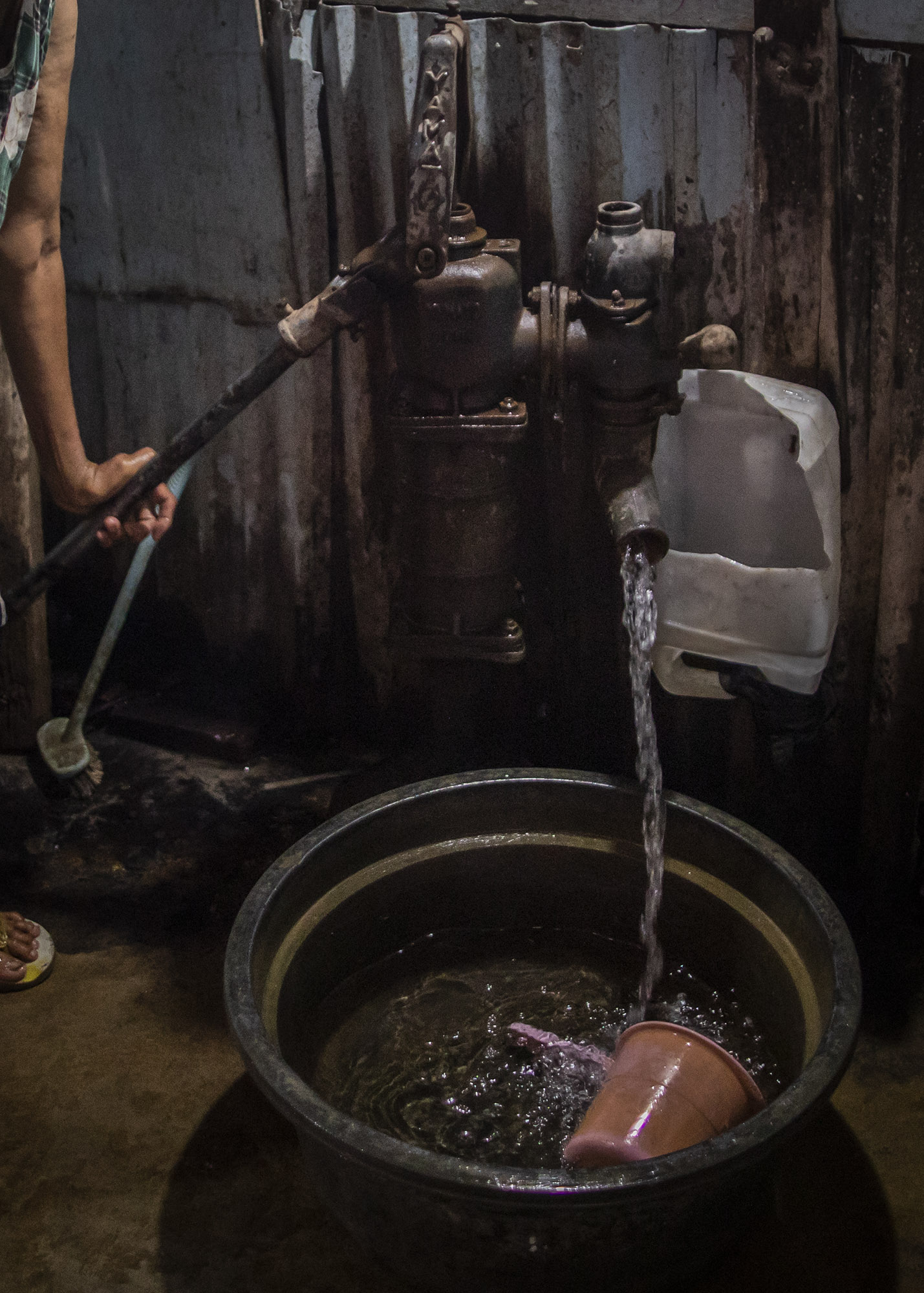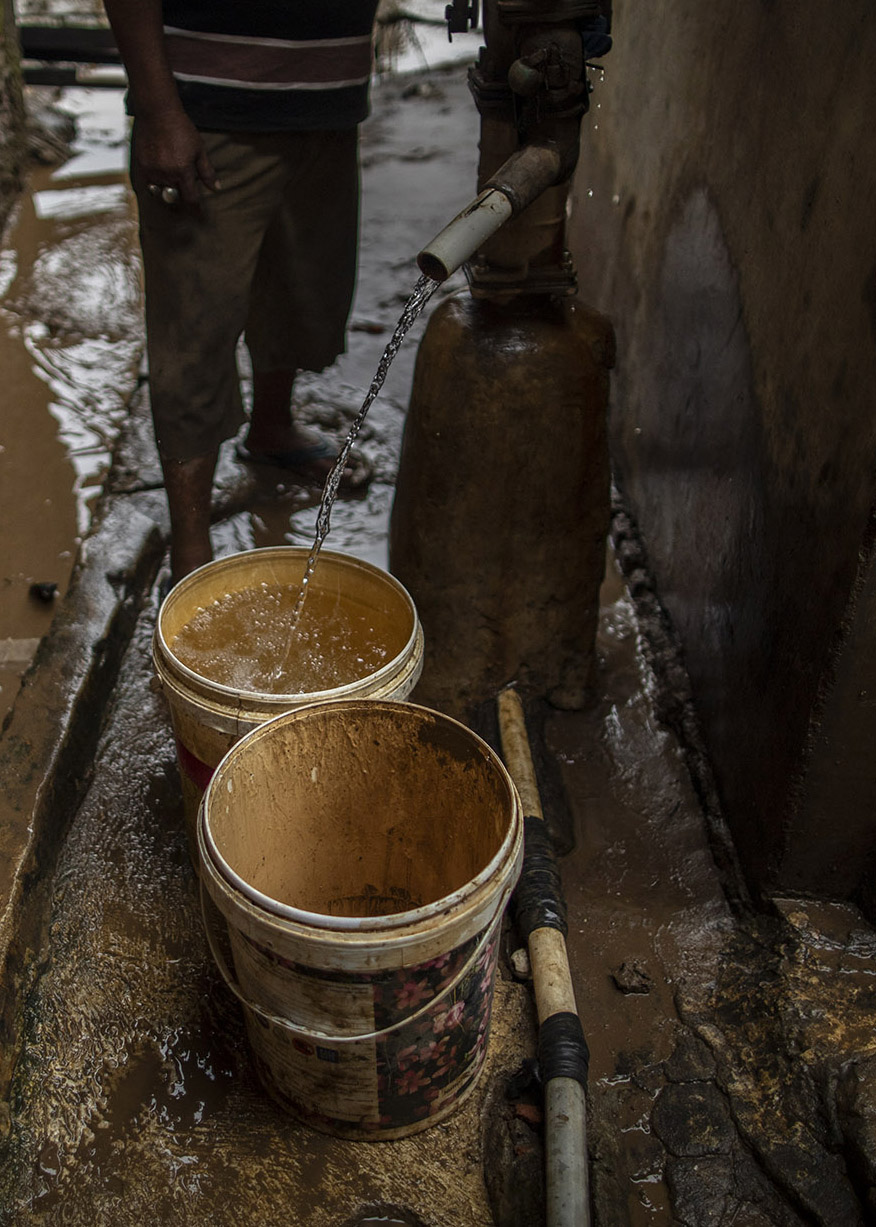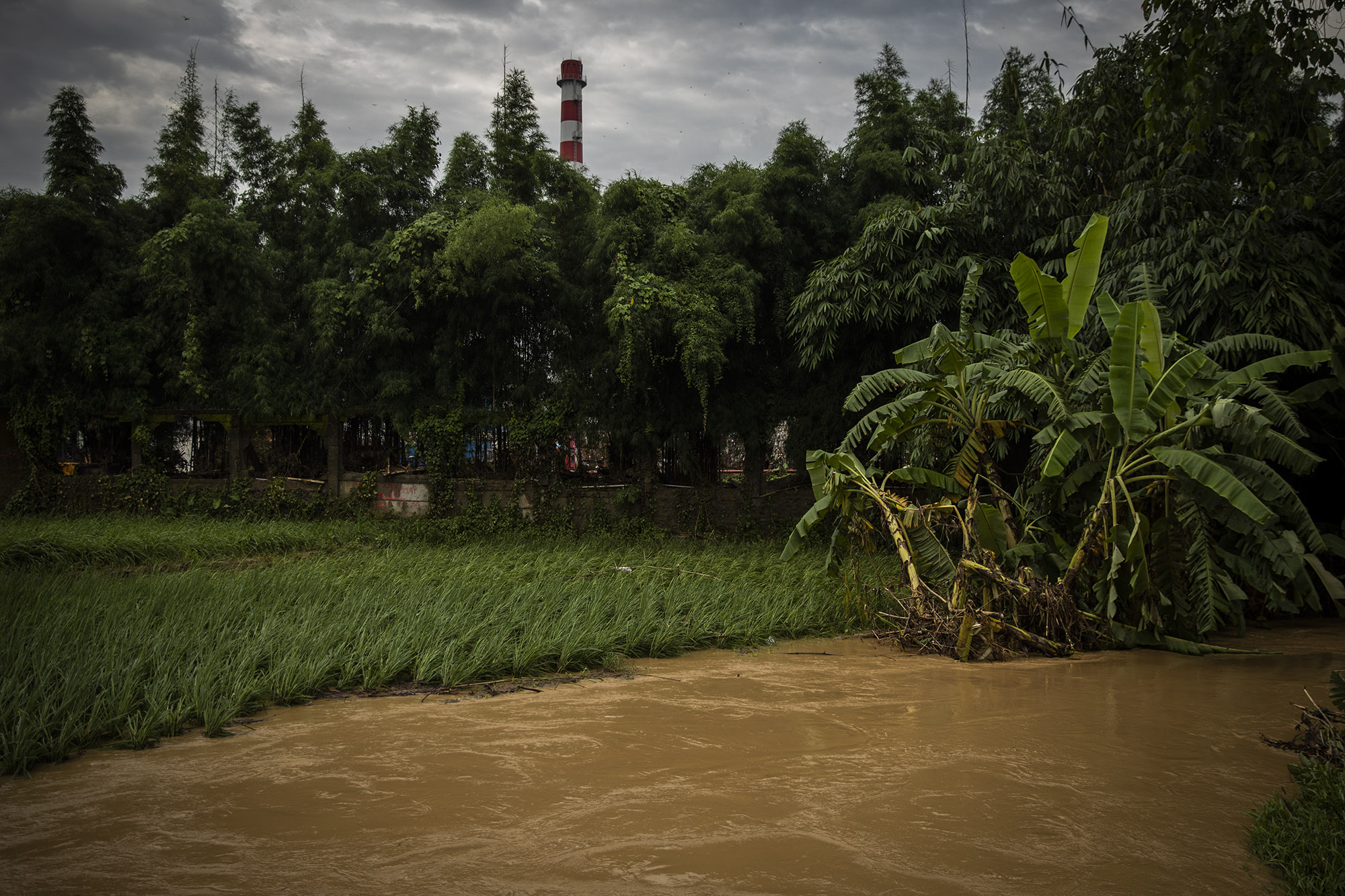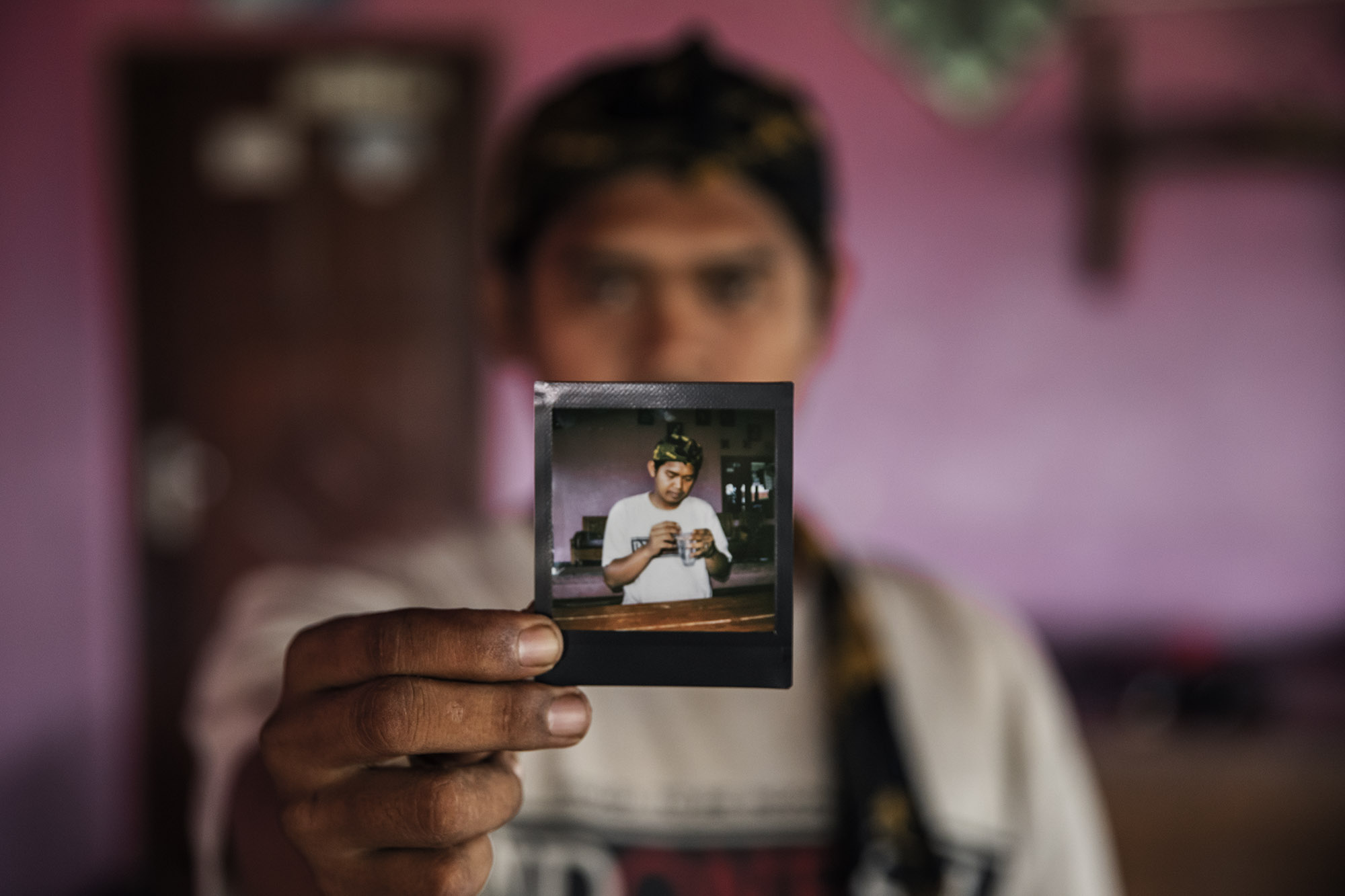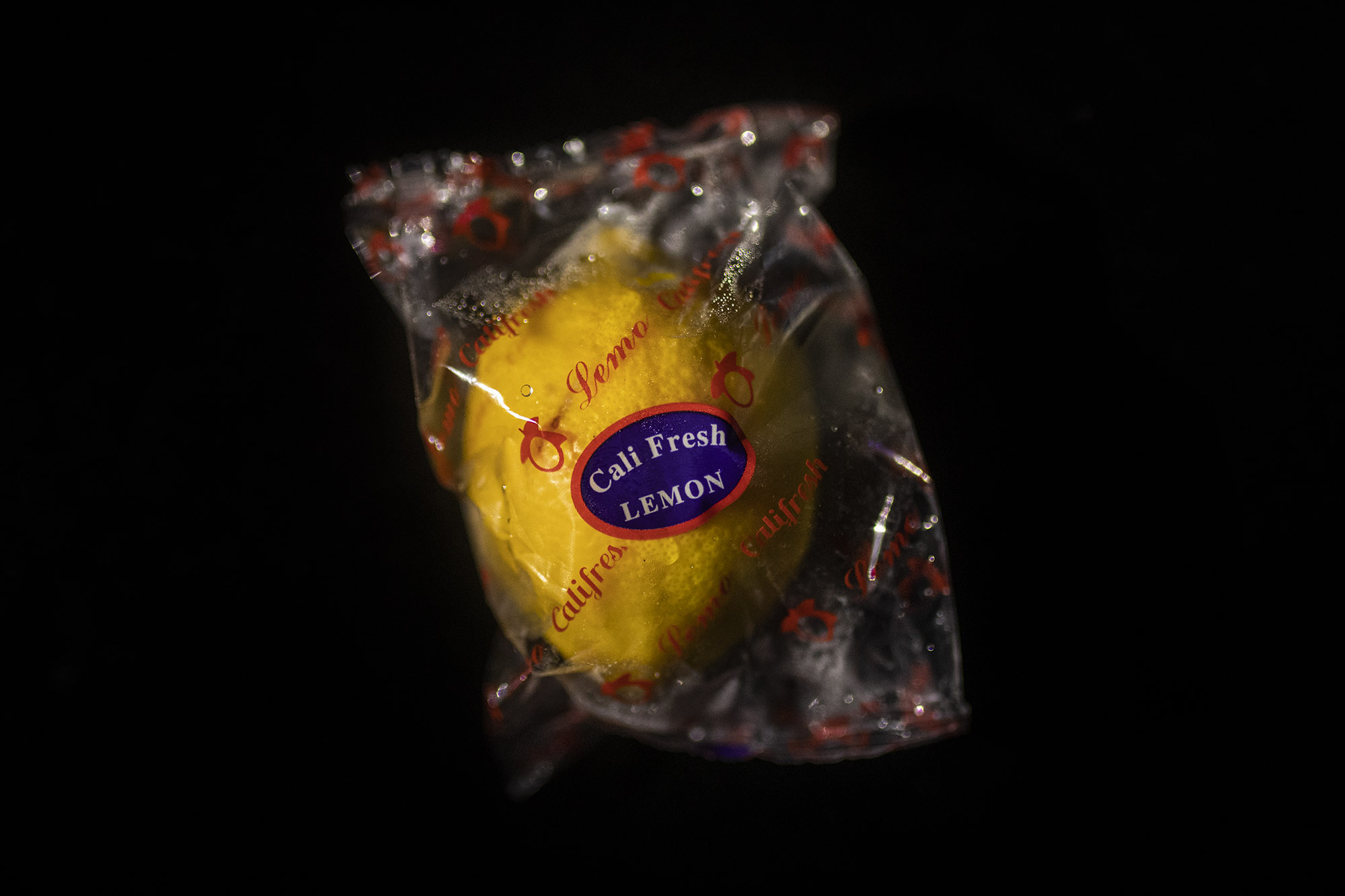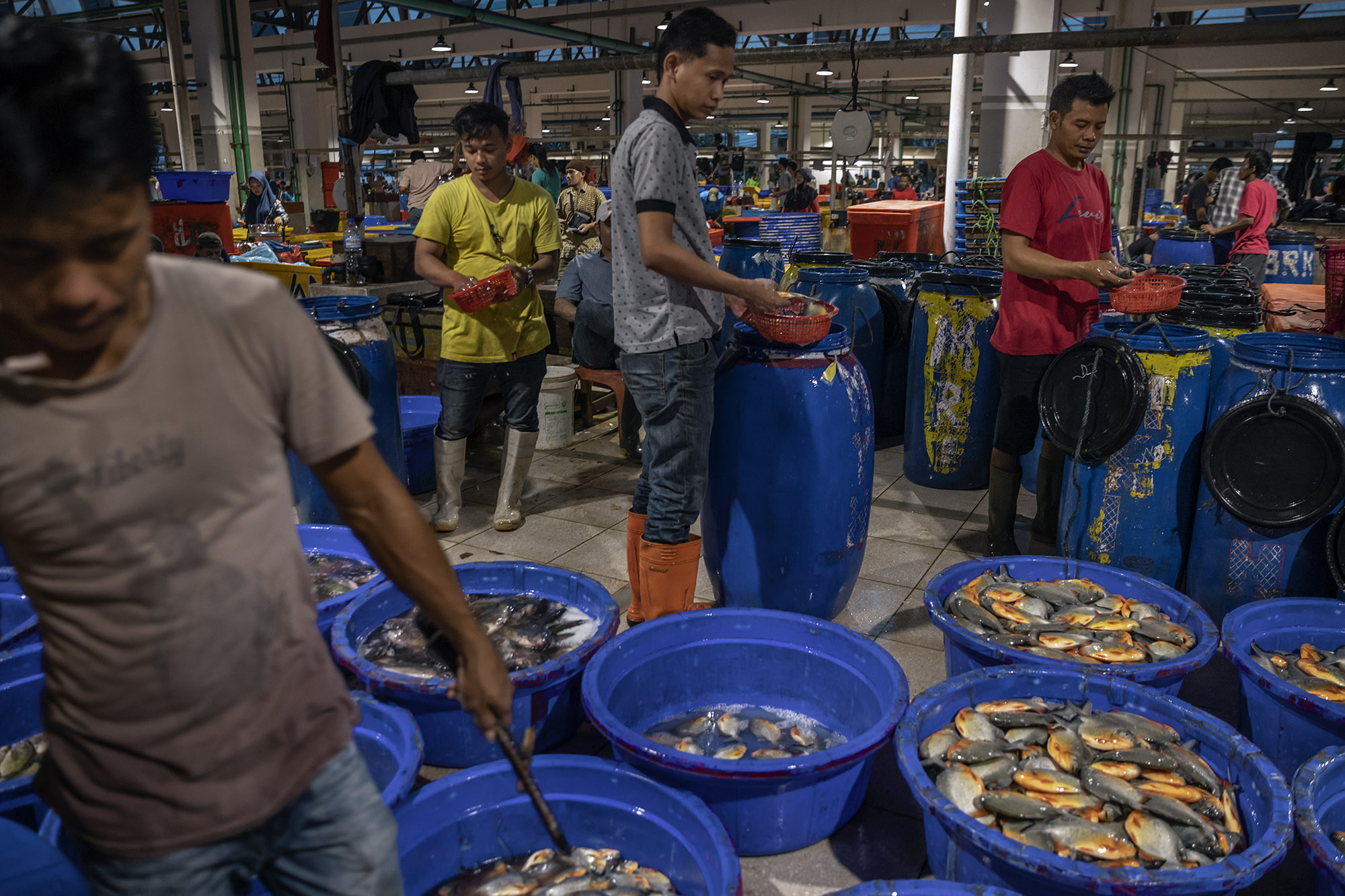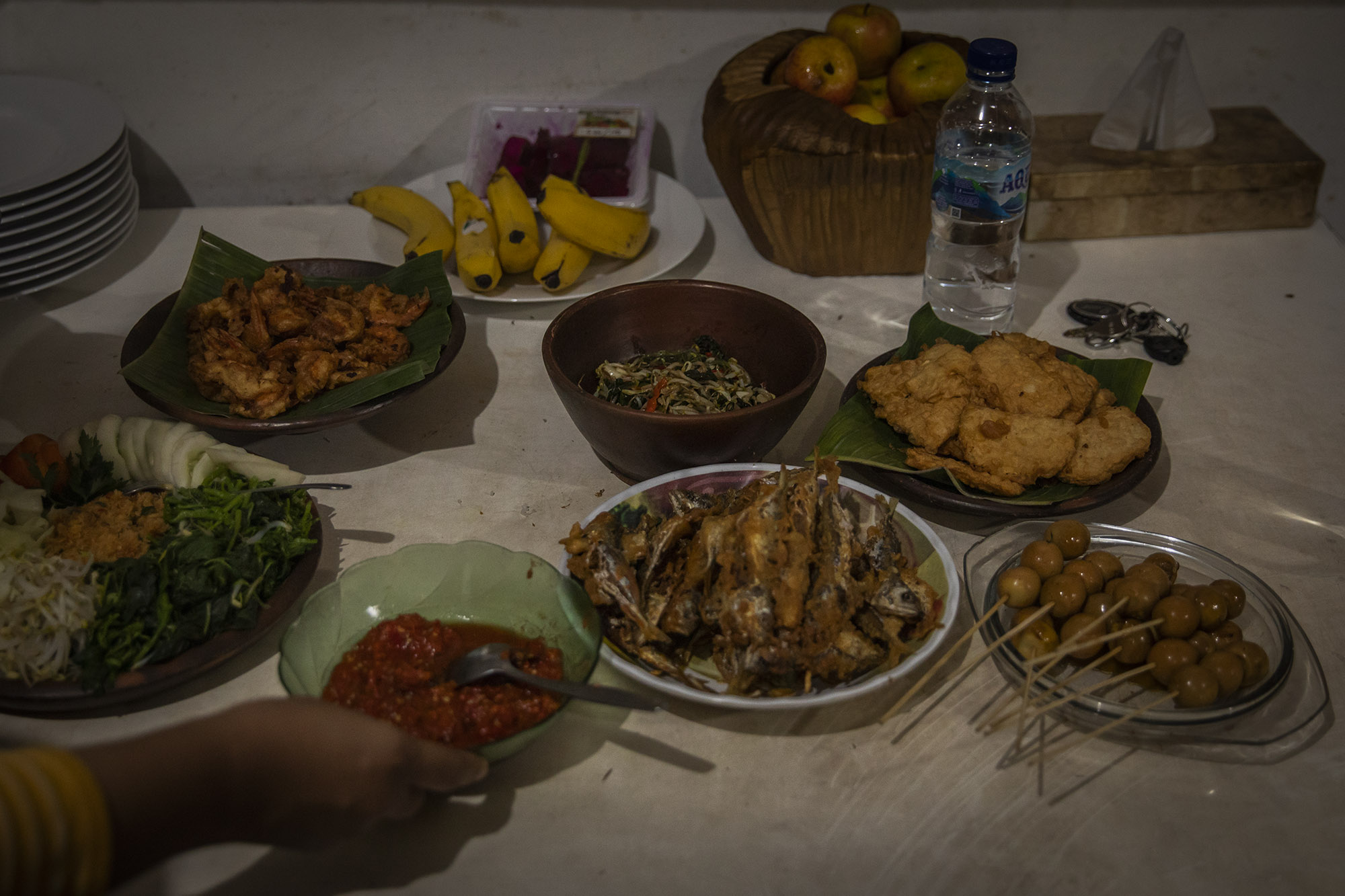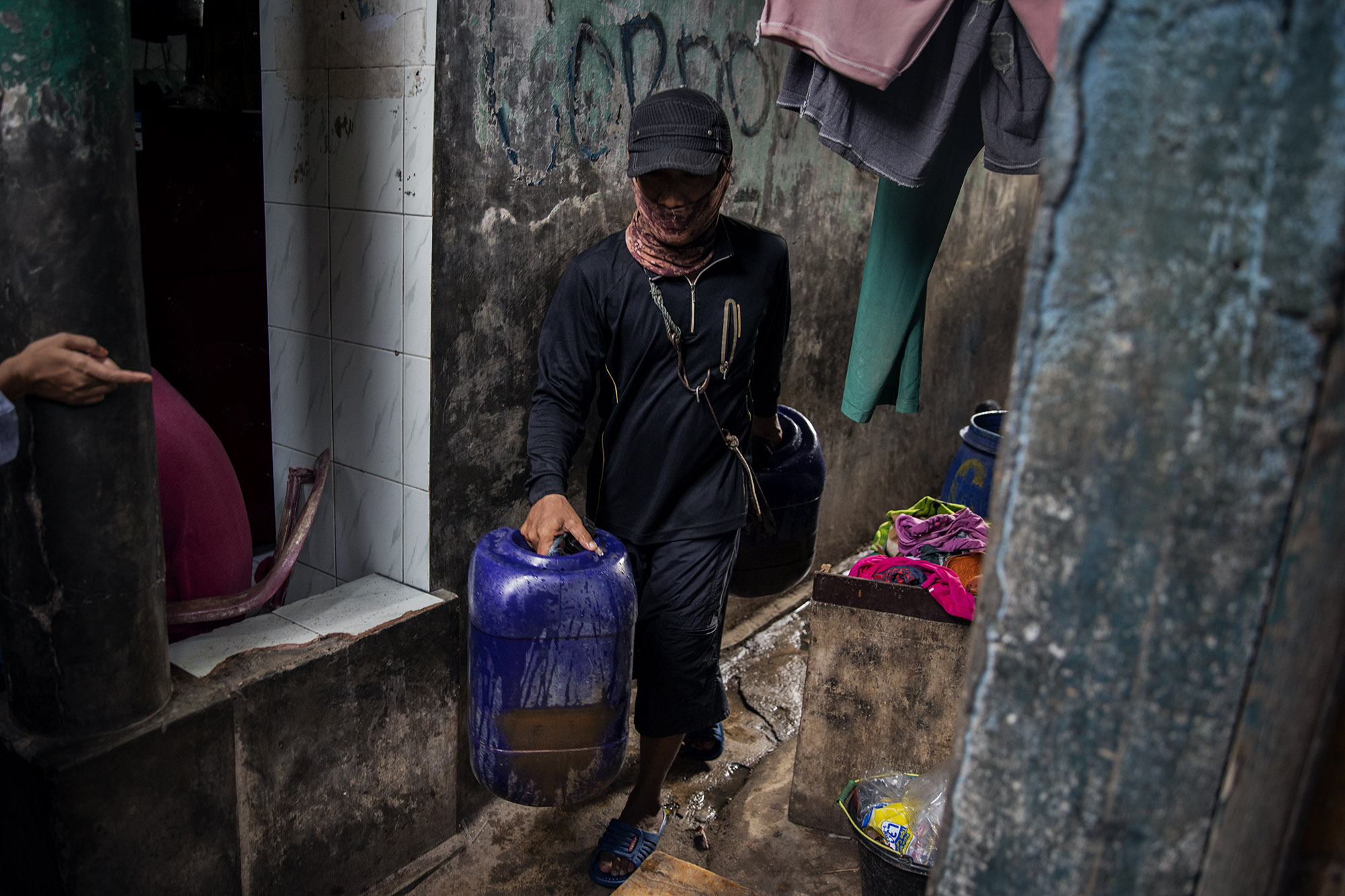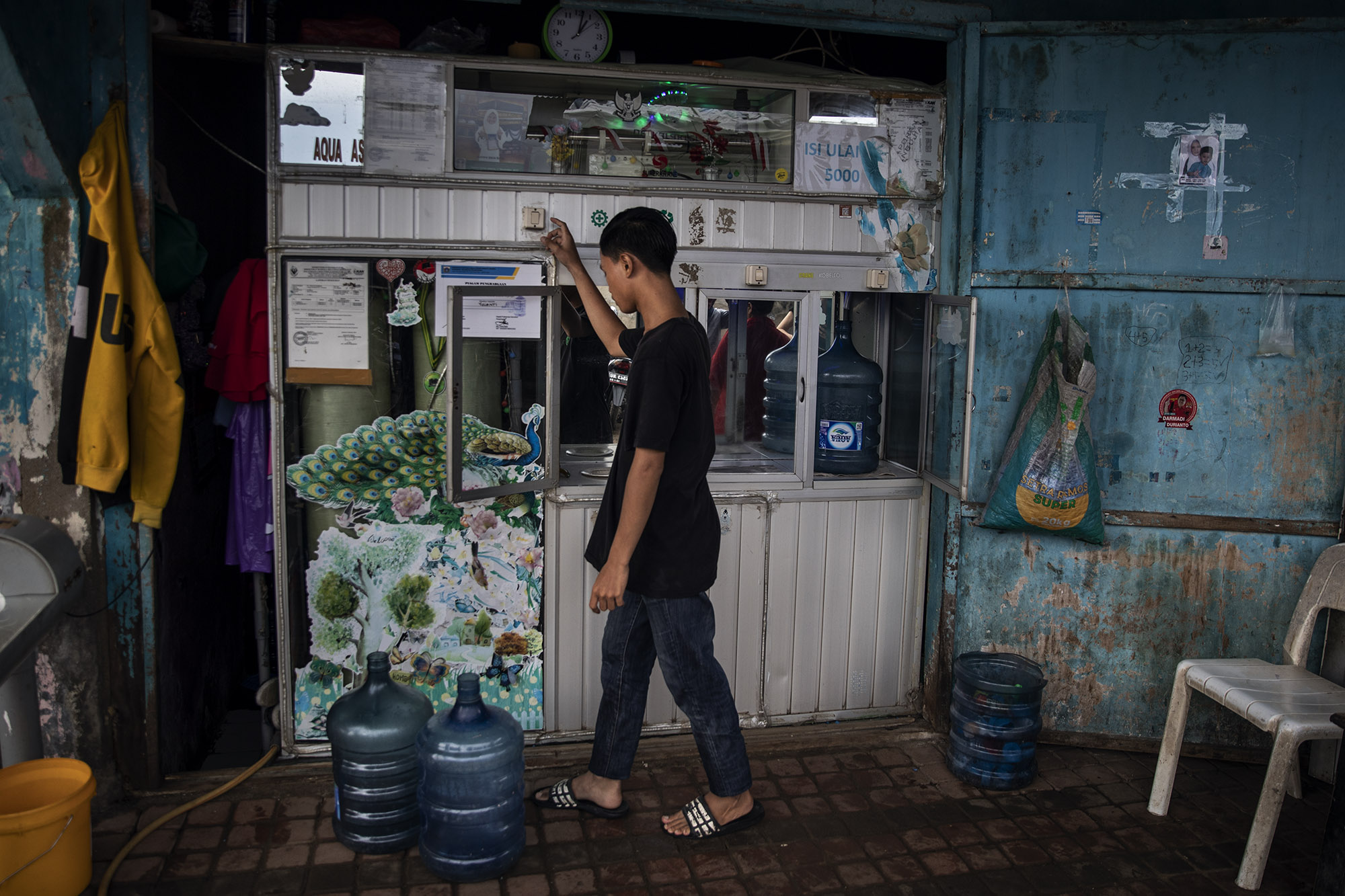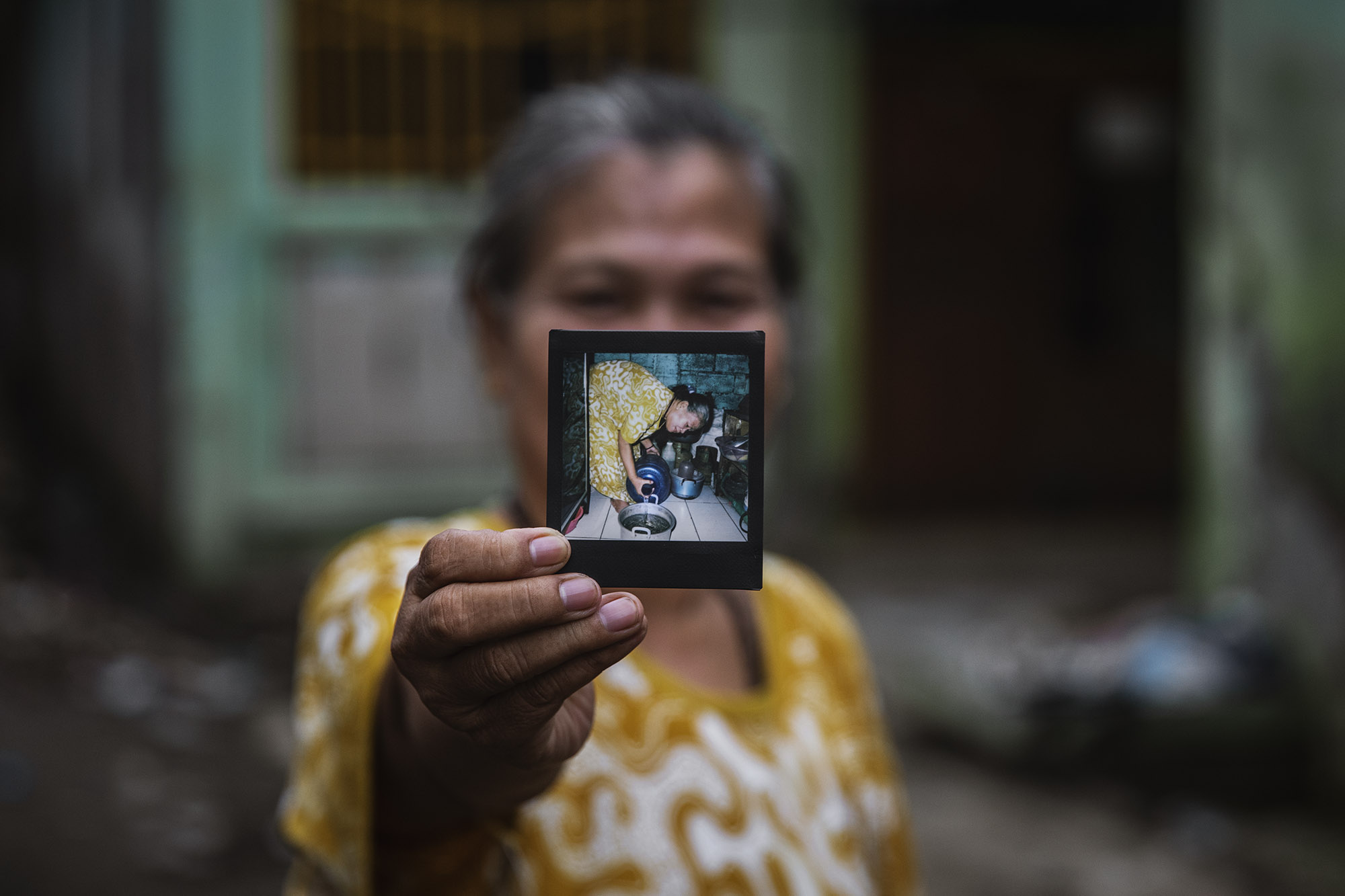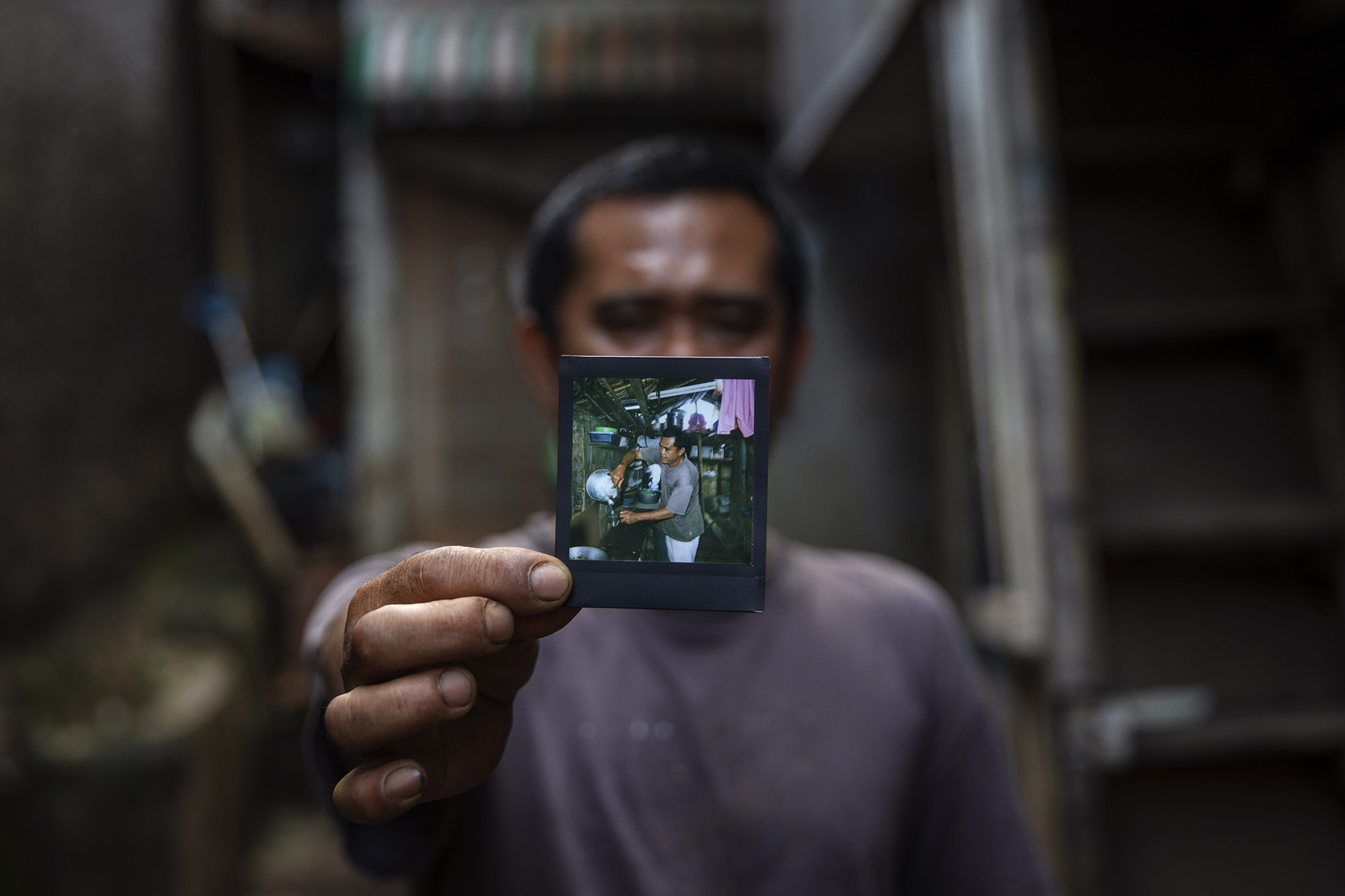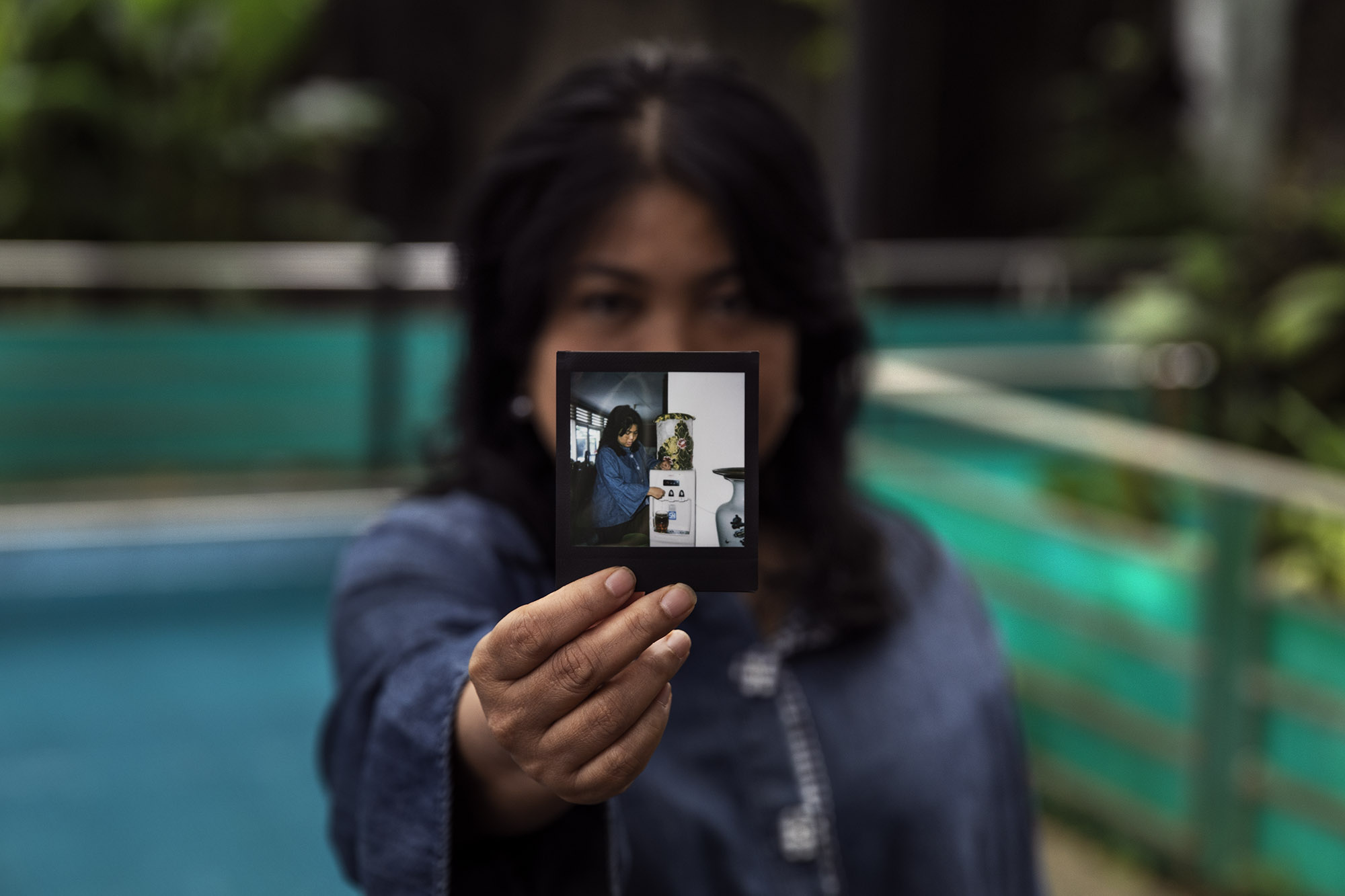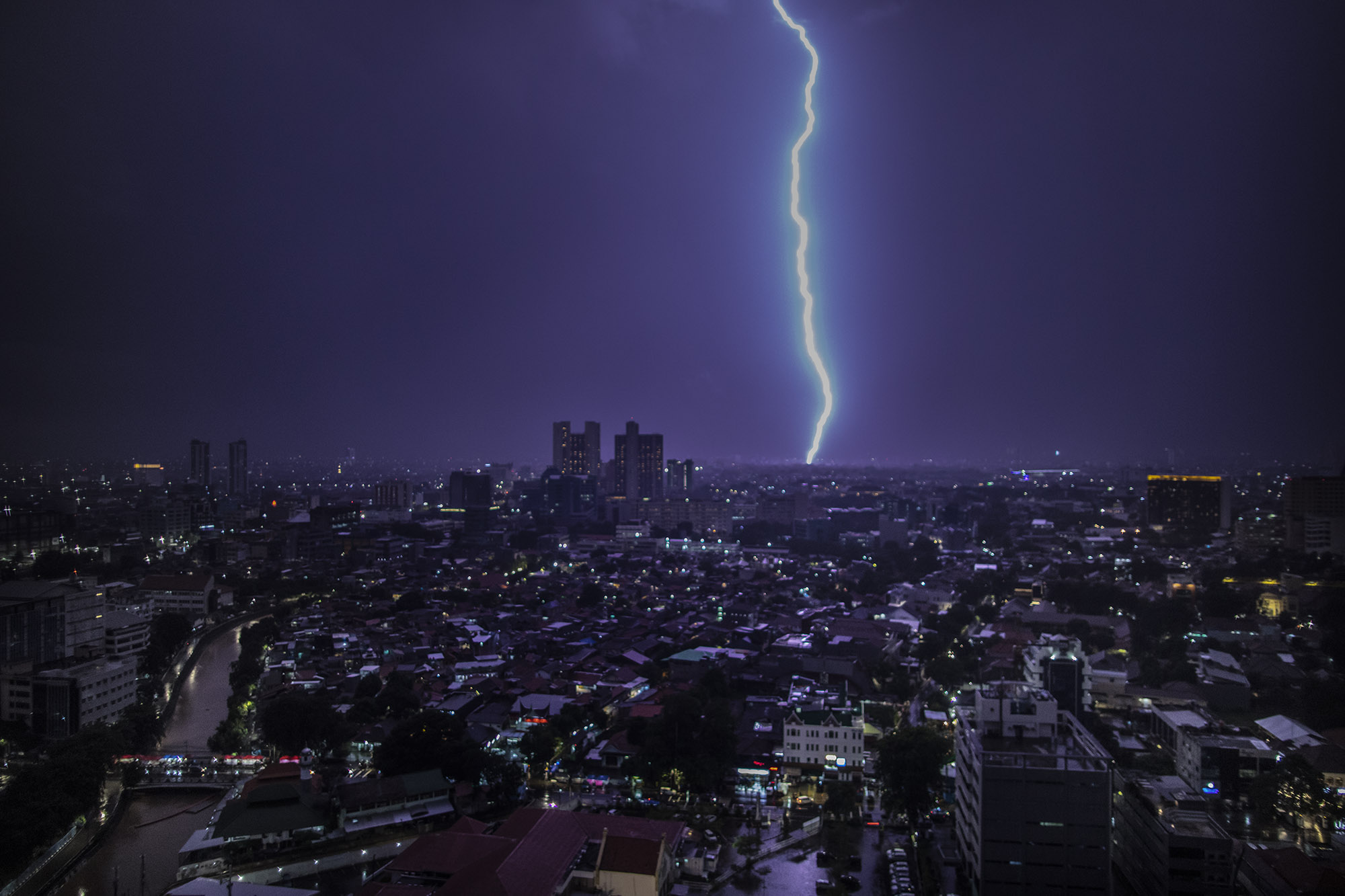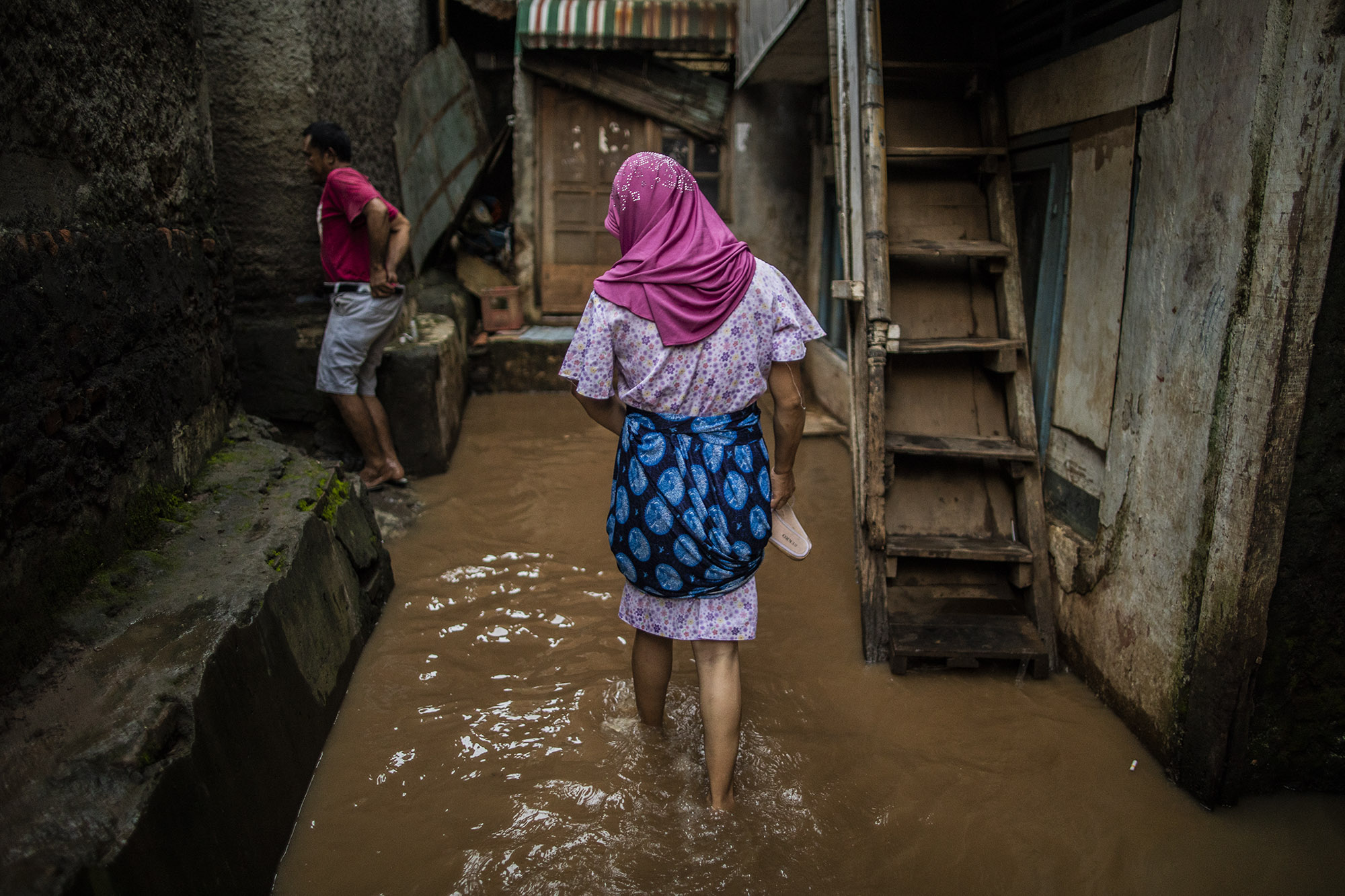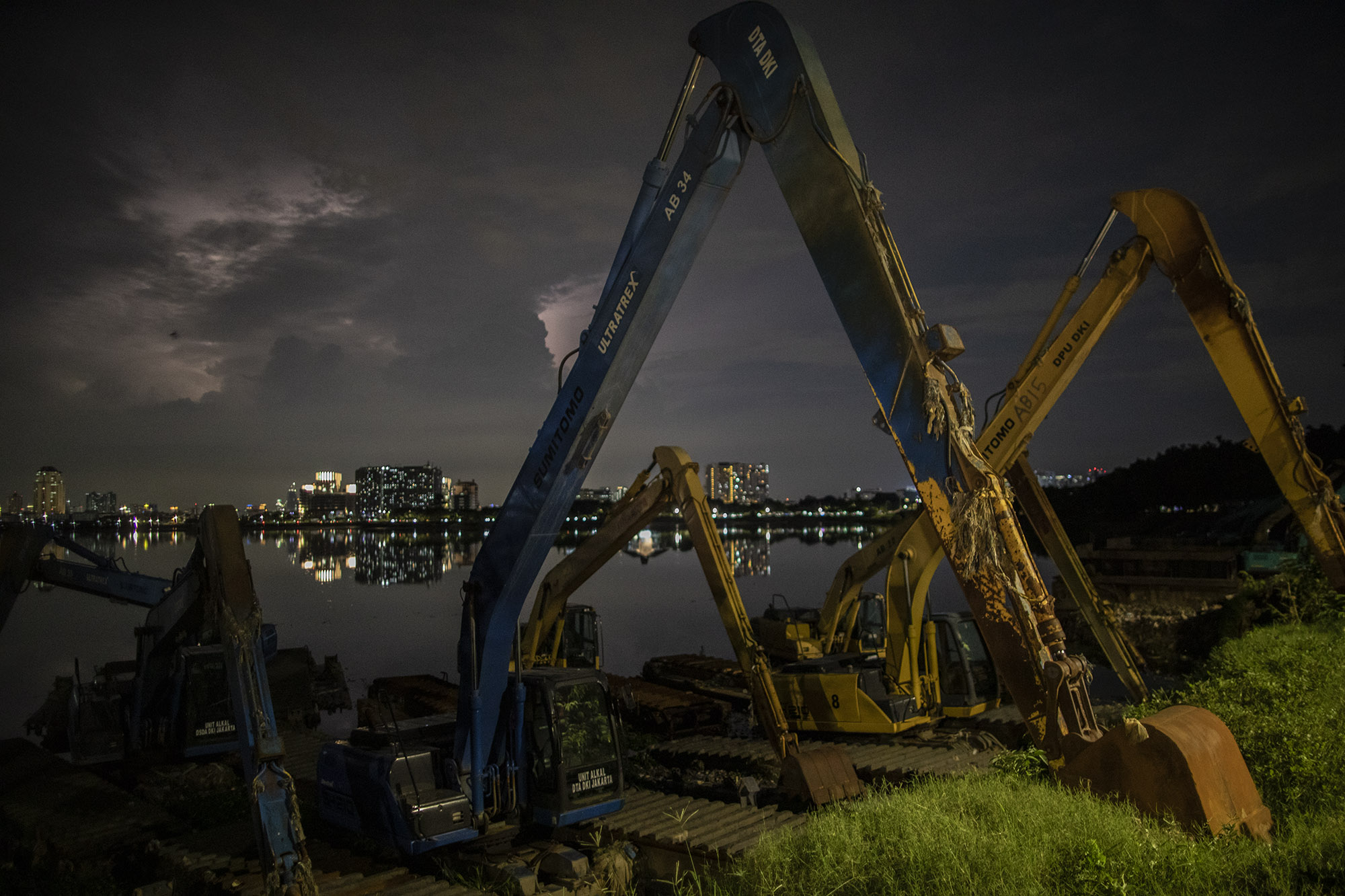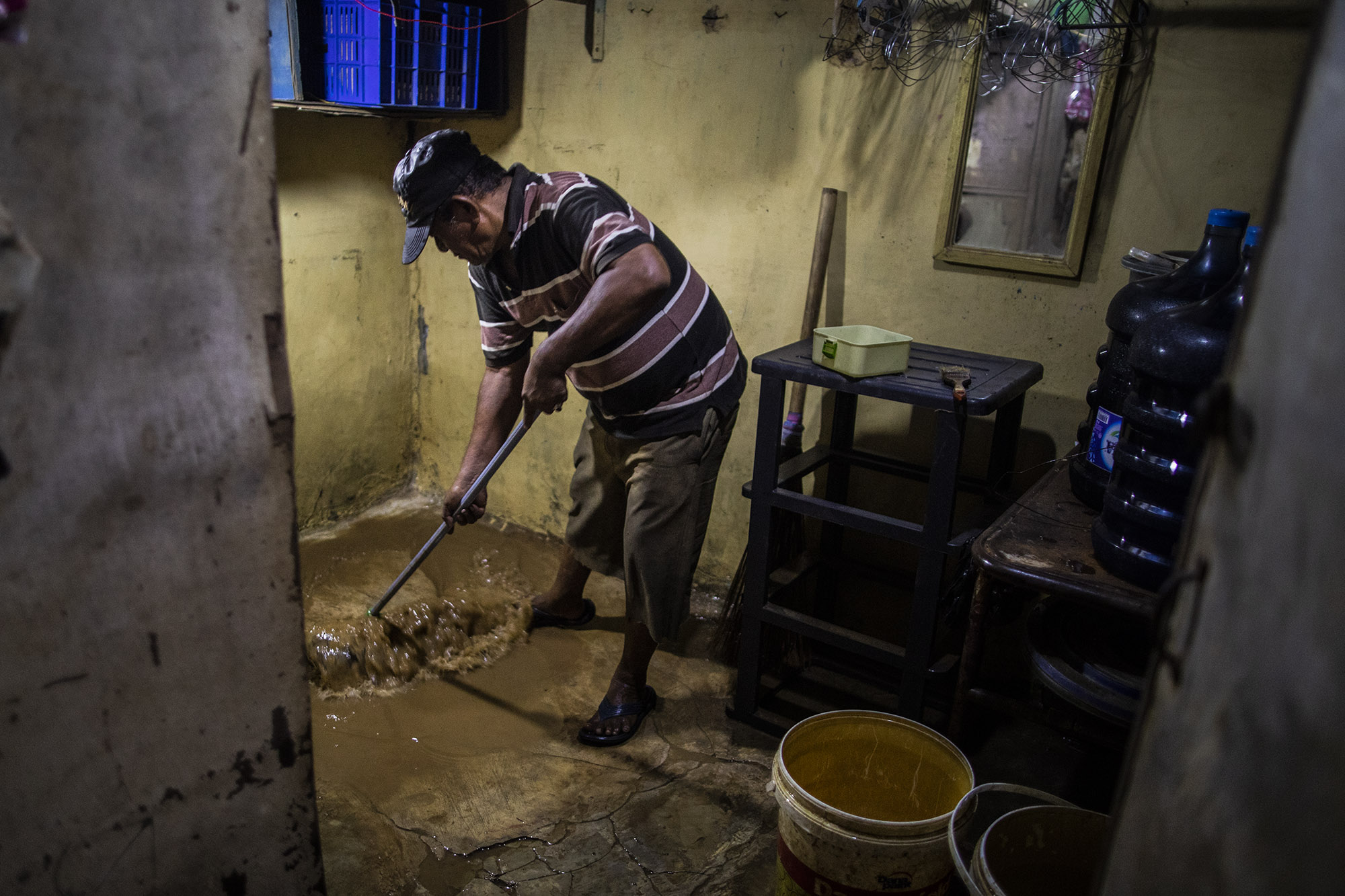© Santi Palacios for Sonda Internacional
Project summary
#megacities&pollutionMegacities and pollution
Megacities and Pollution: The Asian Epicenter is a photodocumentary project that analyzes three of the greatest environmental challenges of the 21st century: plastic waste, poor air quality and water pollution. The project focuses on three megacities in Asia, the most populated continent in the world: Metro Manila, Delhi and Jakarta.
Megacities and pollution
We Thought it Was Fog
New Delhi: The world’s most polluted capi...


Join our crowdfunding!
Take the opportunity to directly support in-depth journalism on the climate crisis
Donate
25 October 2022
Water is becoming increasingly scarce. This, of course, is nothing new. Nor is the fact that a significant percentage of natural disasters —nine out of ten according to the World Bank— are also linked to water. Even as the global population nears 8 billion inhabitants and the frequency of extreme water-related natural phenomena increases, close to 2 billion people have no source of potable water in their homes. Contrary to what many may believe, this problem is not limited to remote rural areas. Some of the largest 21st century metropolises are faced with serious water management issues, often intensified by other problems like pollution. In the capital of Indonesia —the fourth most populated country on the planet and one that registers some of the greatest annual rainfall— water-related challenges are particularly evident.
Jakarta has too much water, but at the same time, water in Jakarta is in short supply. The future of the Indonesian capital is inextricably linked to the liquid element. In this colossal city of 10 million inhabitants, drinking water and water for washing and cooking is as scarce as it is costly. The paradox is that Jakarta is flowing with water, but it comes in the form of contaminated rivers, torrential rains and flooding which, year after year, inundate streets, roads, homes and businesses.
There is yet another factor that is directly related to water —and to climate change— that is putting the future of this Southeast Asian metropolis at risk. With intensified soil erosion and rising sea levels, Jakarta is the fastest sinking capital city in the world. In the triad of insufficient access to clean water, chronic flooding and the sinking of the city, extreme water pollution plays a fundamental role.
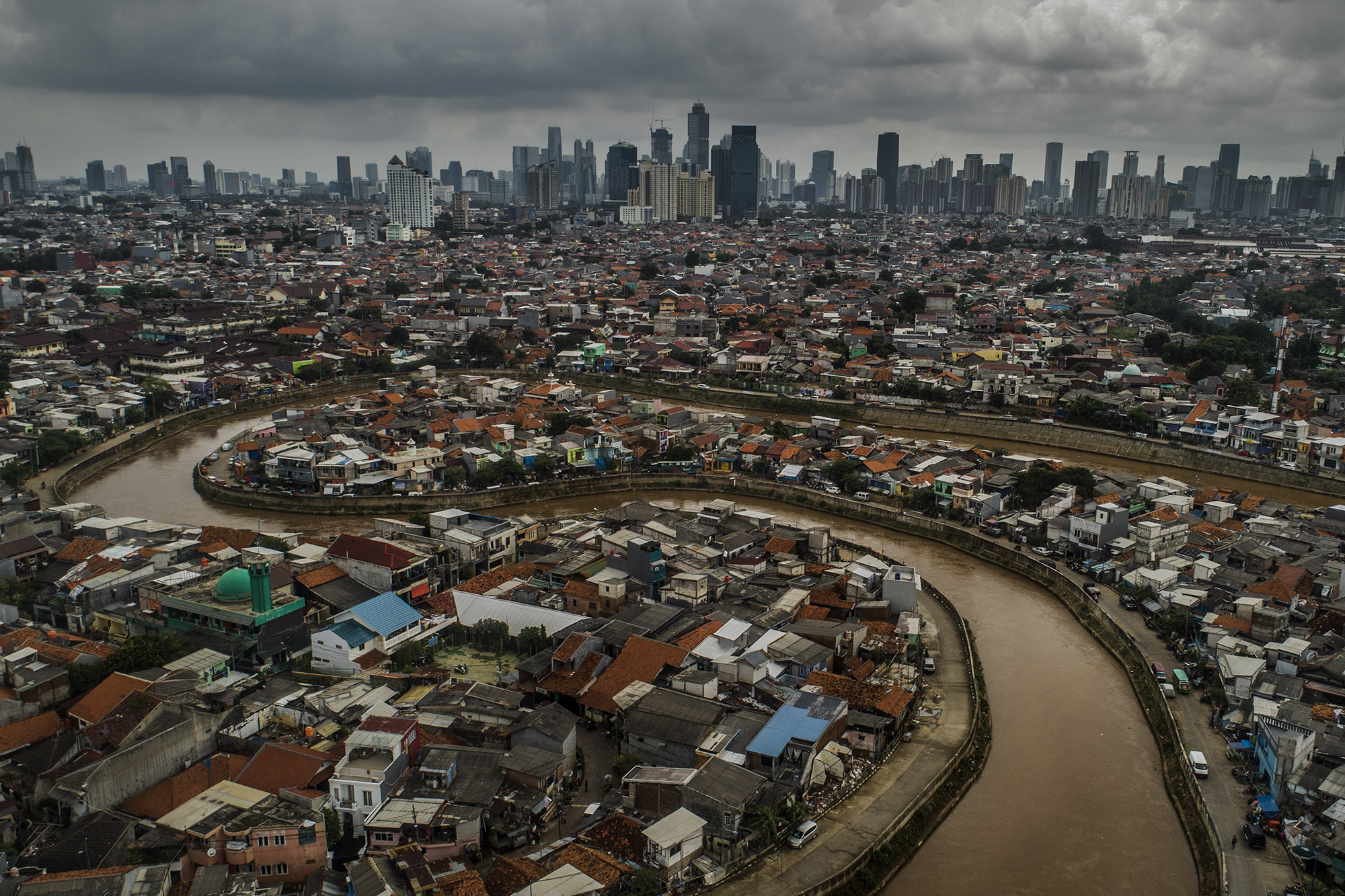
Aerial view of Jakarta © Santi Palacios for Sonda Internacional
Indonesia is the fourth most populated country on the planet after China, India and the United States. Upwards of 280 million inhabitants are spread along an archipelago of more than 17,000 islands. Java —the largest of the archipelago and the most populated island in the world with 145 million inhabitants— is home to the megalopolis of Jakarta.
The 2020 census of the capital checks in at close to 10.56 million inhabitants. But if we include the population of the suburbs (with five satellite cities and four provincial areas), the population of this megalopolis surpasses 30 million, making it the second most populated urban area on the planet after Tokyo.
It also has the largest economy of Southeast Asia. Similar to the rest of the region, economic growth over the last few decades has skyrocketed but the wealth distribution has proven to be highly disproportionate. Data from the Central Bureau of Statistics in Jakarta shows that in March 2021, 28% of the city's population (at least one in four inhabitants) was vulnerable to poverty, at risk of poverty, or below the poverty threshold.
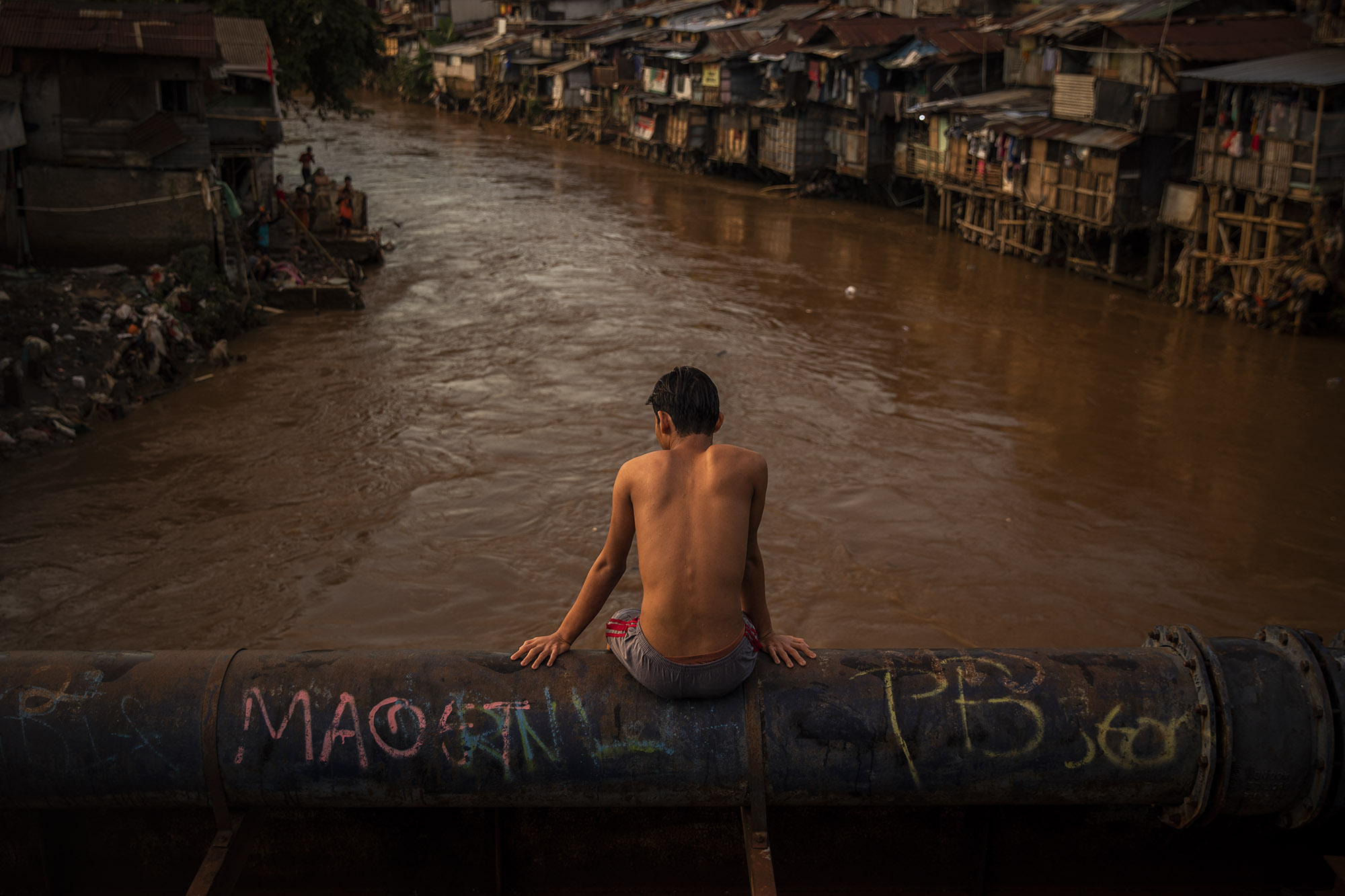
A young man gazes over the Ciliwung as it flows through the center of Jakarta. © Santi Palacios for Sonda Internacional
Such disparities are highly visible in a metropolis where skyscrapers coexist with kampungs: informal settlements that have cropped up throughout the city, entirely lacking in urban planning or utilities. Rapid urban development has converted Jakarta into a congested metropolis with thousands of heterogeneous buildings, traffic-choked roads, industrial parks and infrastructures that occupy the nearly 250 square miles of the city.
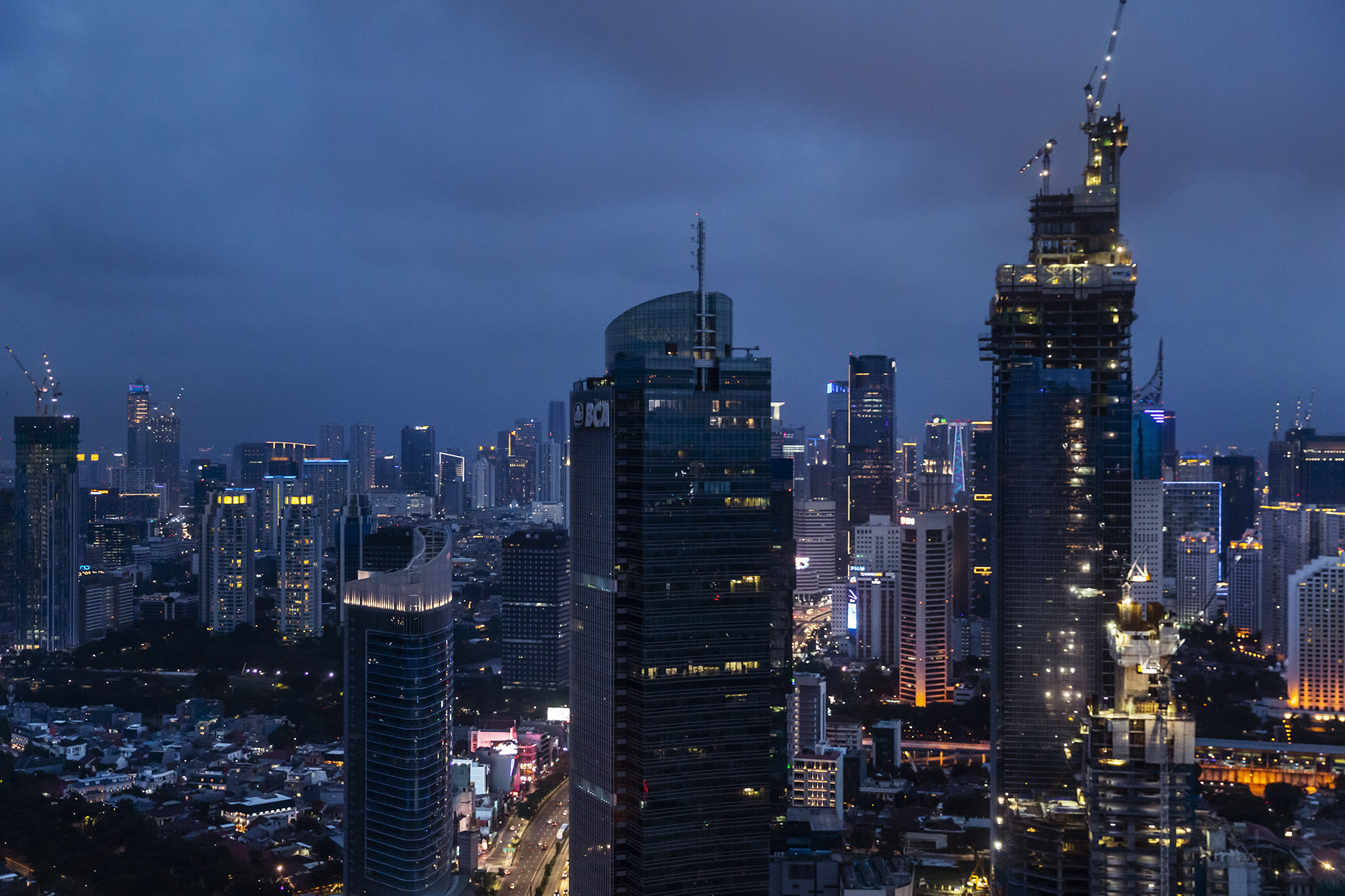
Vista del distrito de Menteng, en Yakarta Central. © Santi Palacios para Sonda Internacional
Forty per cent of Jakarta’s surface area lies below sea level. This, together with the serious drainage problems of the 13 rivers and canals that flow through the city, is the cause of chronic flooding during the annual rainy season, which generally lasts from October until March or April. Rainfall during these months typically causes the river system to overflow its banks, while thousands of people resign themselves (albeit unwillingly) to having their streets and neighborhoods submerged underwater year after year.
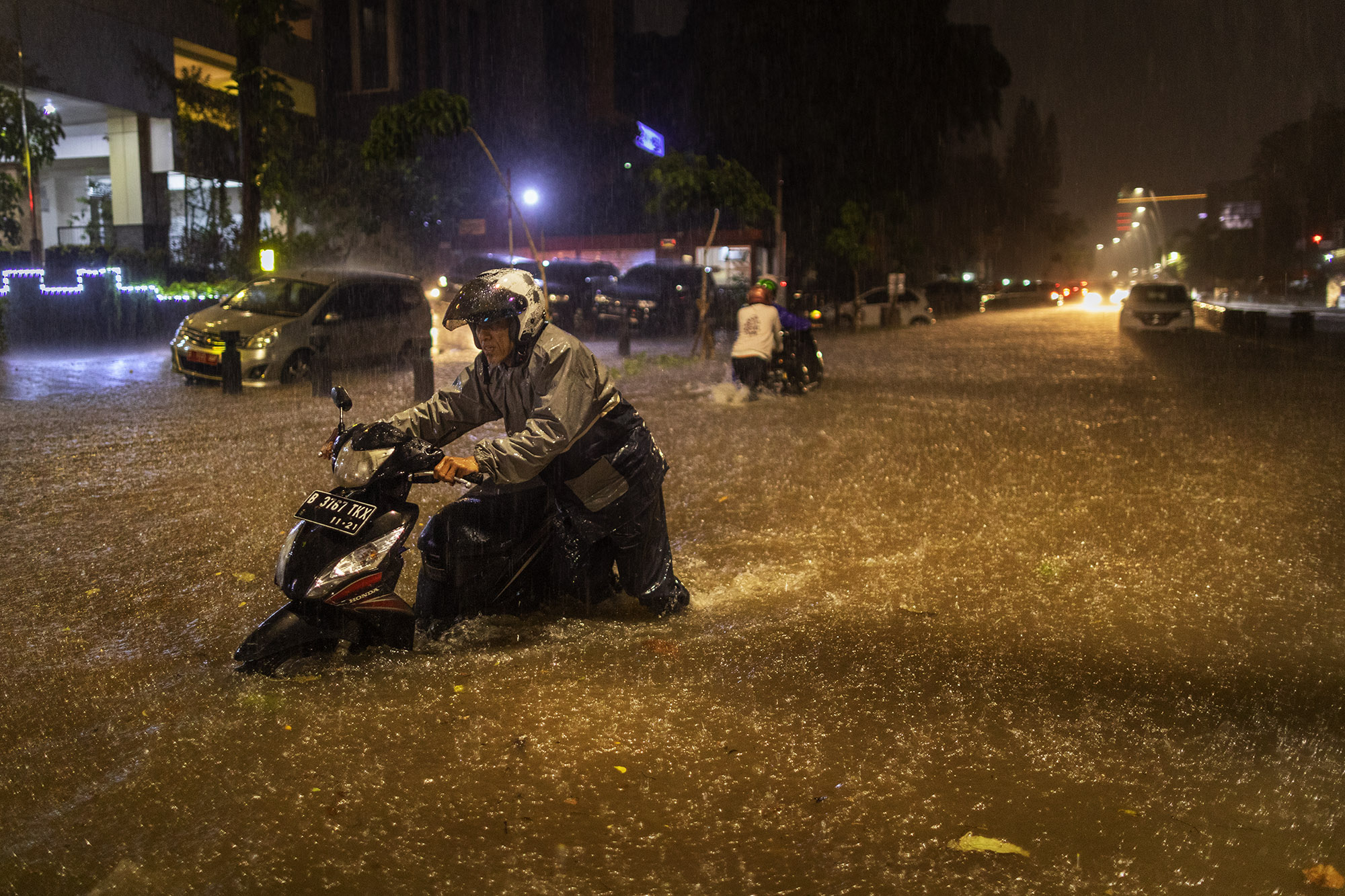
A man pushes his scooter along a flooded avenue in downtown Jakarta during a heavy storm. © Santi Palacios for Sonda Internacional
Urbanization of the area also prevents rainwater from entering the subsoil and replenishing underground aquifers, which is crucial in Jakarta, where the water supply network is insufficient and millions of people depend directly on groundwater to cover their needs.
The number of wells for extracting groundwater has exploded in the last century. In 1920, when Jakarta was a Dutch colony (a situation which lasted until Indonesia's proclamation of independence in 1945), there were 28 wells in the city. Today there are thousands, functioning both officially and illicitly. Data from 2016 set this number at 4,270, although this is merely an estimate. And despite legislation in place to regulate groundwater extraction, this figure continues to grow. Overexploitation of aquifers strains the land, causing a city already threatened by rising sea levels to sink even further. In some neighborhoods in the north of Jakarta, the land can sink up to eight inches per year.
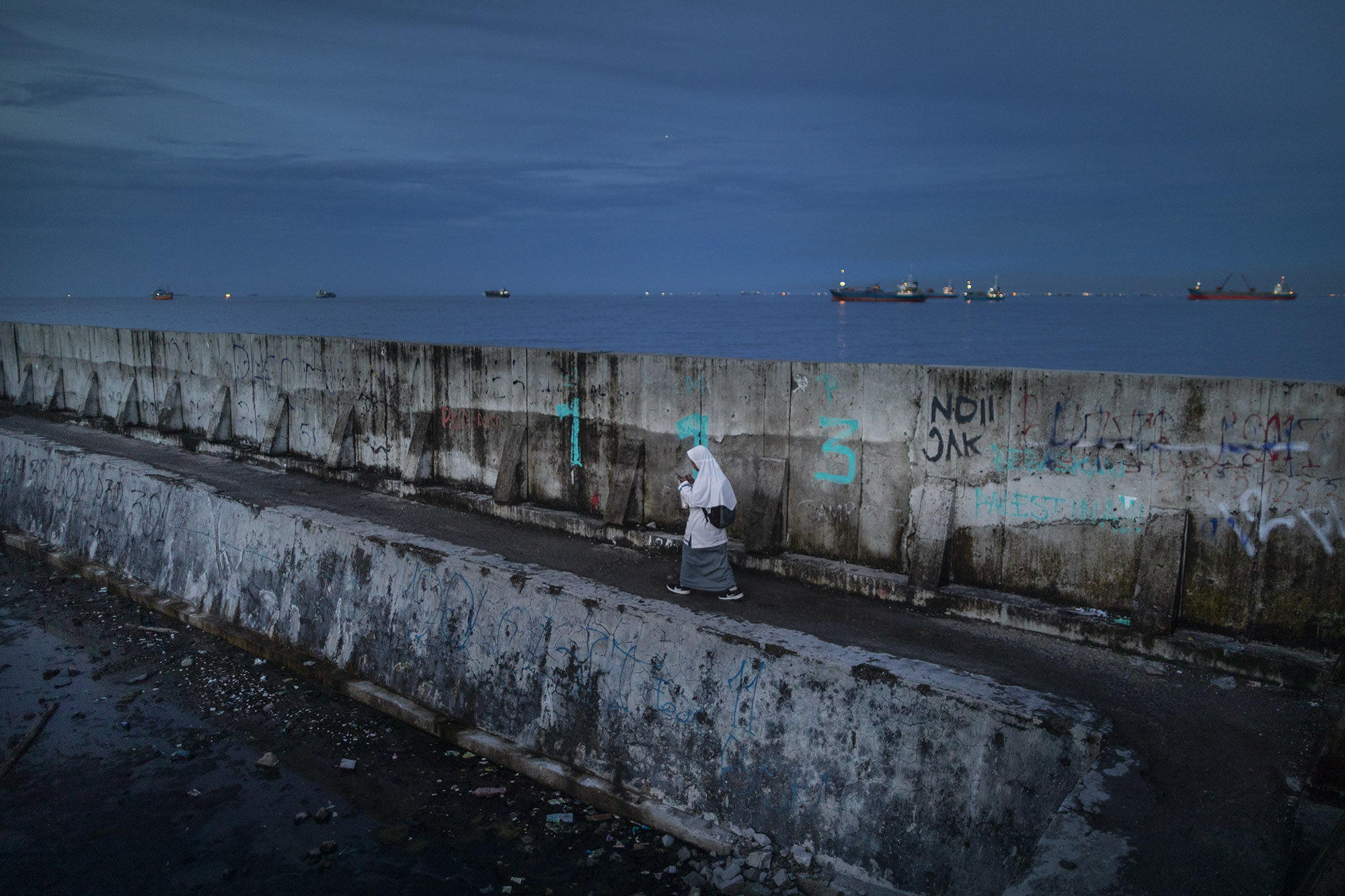
A young woman walks along the water retaining wall erected in Muara Baru, in the north of the city, to halt the advance of the sea. © Santi Palacios for Sonda Internacional
“Water is linked to every aspect of human existence,” says Sumengen Sutomo, a senior researcher at the University of Indonesia and expert in environmental health and water quality. Of all of the water-related issues Jakarta is facing, from flooding to sinking, Sutomo points to the primary and most significant problem: “A lack of access to safe drinking water.”
CONTAMINATED WATER
Jakarta’s rivers and aquifers are among the most polluted on the planet. Tons of waste from factories along the shores of the rivers that flow through the metropolis are dumped directly into the waters, in addition to raw domestic waste from millions of homes that ends up in the city's waterways. Despite its status as the largest megalopolis in Southeast Asia, Jakarta has no public sewage system. A 2021 study by the World Bank calculates that nine out of ten homes in the Indonesian capital use latrines or septic tanks. Some of the most exclusive condominiums have private sewage treatment facilities, but they do not always comply with minimum standards and often end up leaching sewage into the subsoil.
Contamination is not homogeneous, and levels vary depending on the type of analysis and the established parameters. Dr. Sutomo says that “no one really knows the true quality of the water” in Jakarta. According to data from the Department of the Environment gathered in 2020 by the NGO Friends of the Earth, 35% of Jakarta's groundwater was “slightly polluted”, 21% was “considerably polluted”, and 12% was “extremely polluted”. Only 32% was considered “good quality”.
It was also found that the city's main rivers (Ciliwung, Citarum, Cidurian, Cisadane and Bekasi) are either “considerably” or “extremely” polluted. Profuse amounts of nitrates, phosphates and ammonium, typically originating from agricultural runoff and domestic waste, have been found in the waters. Heavy metals like mercury and lead deriving from industrial and urban waste also surpass standard thresholds, as reported by the World Bank.
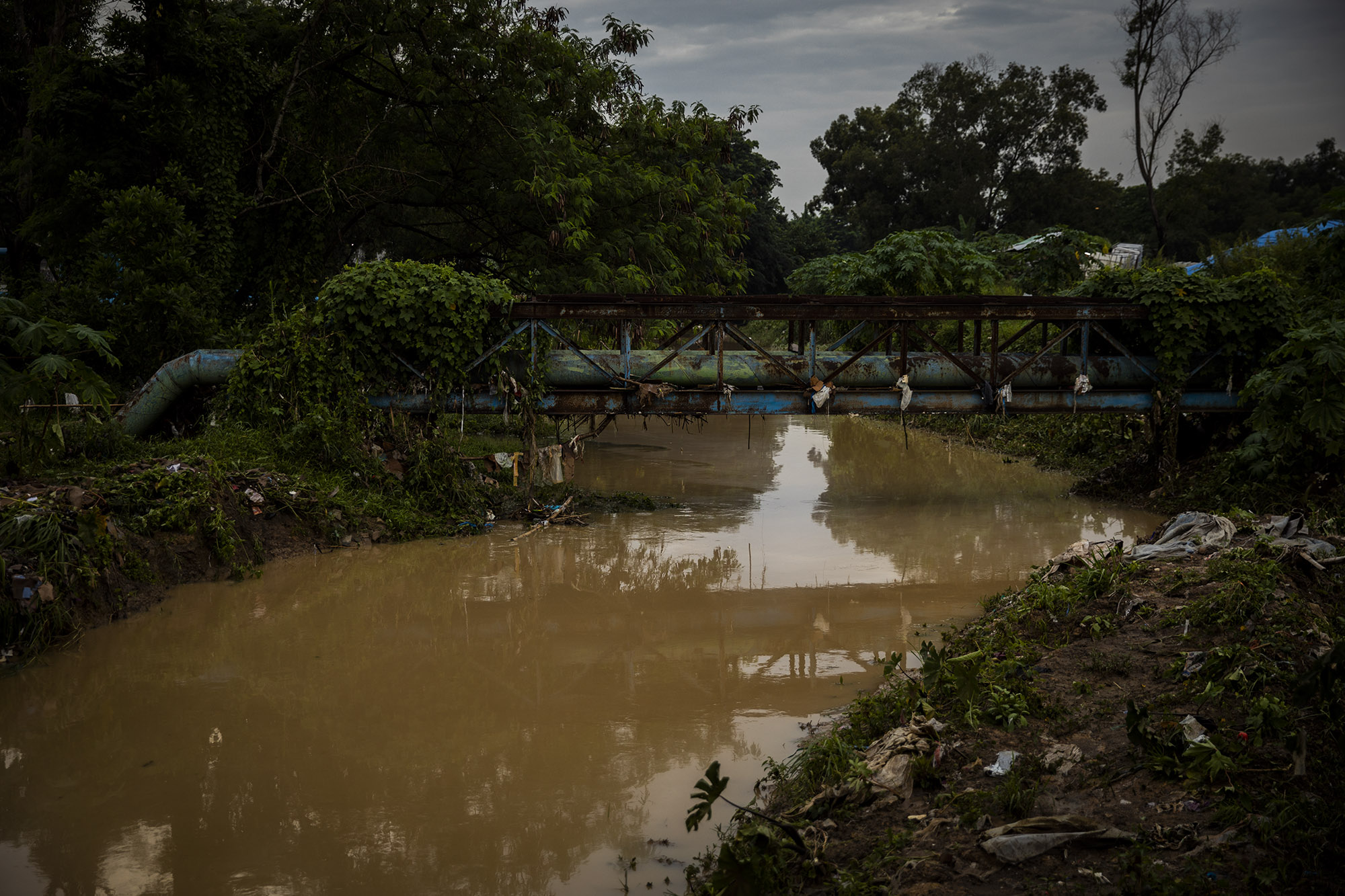
A tributary of the Citarum river cuts through an industrial area in Karawang, in eastern Jakarta. © Santi Palacios for Sonda Internacional
The Citarum River has been for years a bleak example of the impact of pollution, invariably appearing near the top of the list of the most polluted rivers in the world. Its source is near Bandung, the third-largest city of Indonesia, and it flows for 180 miles before emptying into the bay east of Jakarta. Countless industries crowd the shores of the Citarum and the river basin —nearly 3,000 according to data from 2018— and the waste invariably ends up in the waters of the river.
Various attempts have been made to regenerate the river and the surrounding environment. In 2018 the Indonesian government launched the Citarum Harum (fragrant Citarum) project, one of the most ambitious watershed restoration initiatives in the world. The goal is to transform the river, which contains elevated levels of toxic waste and sewage, into a source of drinking water. The program expires in 2025. Progress has been made and the river is cleaner in some sections, but the project is far from achieving its goal. Water testing has detected fecal coliform bacteria at levels 5,000 times the limit considered to be safe.
Even so, a large part of the population in rural areas near Jakarta uses contaminated river water to irrigate their fields and cover part of their basic needs. On top of that, 80% of the water that flows through the pipes of Jakarta’s limited water supply networks comes from the Citarum. Although the water is filtered through treatment plants, in the capital it is considered “not safe at all", says Sumengen Sutomo. Among other problems, the scientist is critical of the fact that more is not being invested in treating and purifying the water. “It is not a government priority. They continue to build infrastructures, but they completely ignore the issue of drinking water.”
Aep
Aep Saifulloh is 32 years old and lives in the village of Jati Mulya, in the region of Karawang, some 30 miles east of Jakarta. He says that sometimes the Citarum is full of foam, or the water is very dark and foul smelling, or it bears dead fish and other animals along its course. Even so, many people in the village use the water of the Citarum for washing clothes, rinsing rice or bathing, even though it can cause a rash or itching. They sometimes even use the river water for the most basic of necessities: drinking. “The water is left to sit for a few days to allow the sediments to separate. Then it is filtered and boiled.”
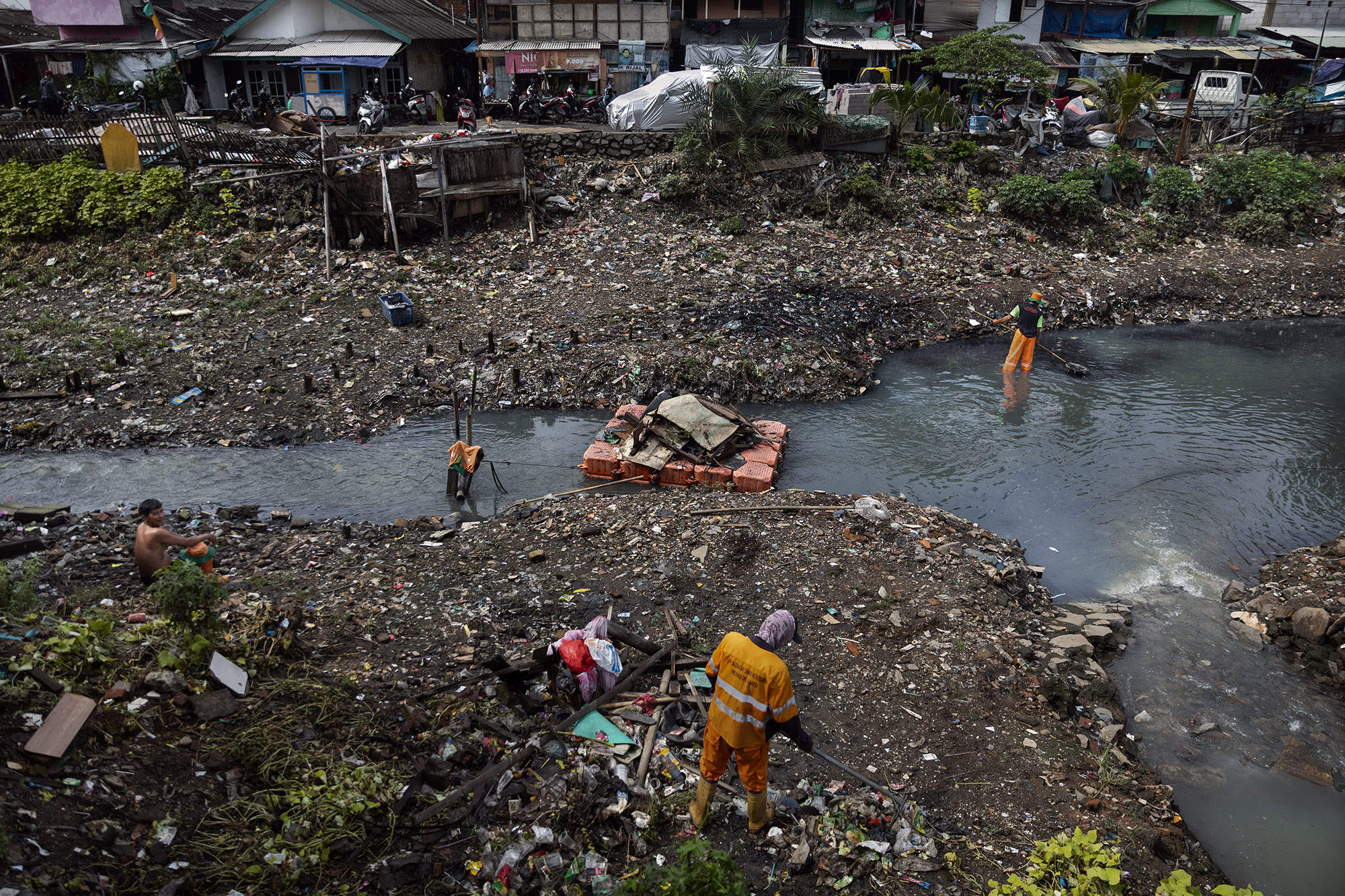
Municipal workers cleaning a river that cuts through the north of Jakarta. © Santi Palacios for Sonda Internacional
When the Citarum and other rivers like the Ciliwung —which flows through the center of Jakarta— reach the metropolitan area, the less visible pollution is compounded by solid waste from the city. More than 7,000 tons of waste per day are dumped into the gigantic Bantar Gebang landfill, the largest of the city's 11 dumpsites. Indonesia and other Southeast Asian neighbors, like the Philippines, often top the list of countries that dump the most plastic waste into the sea, despite the fact that much of this plastic originates in western countries.
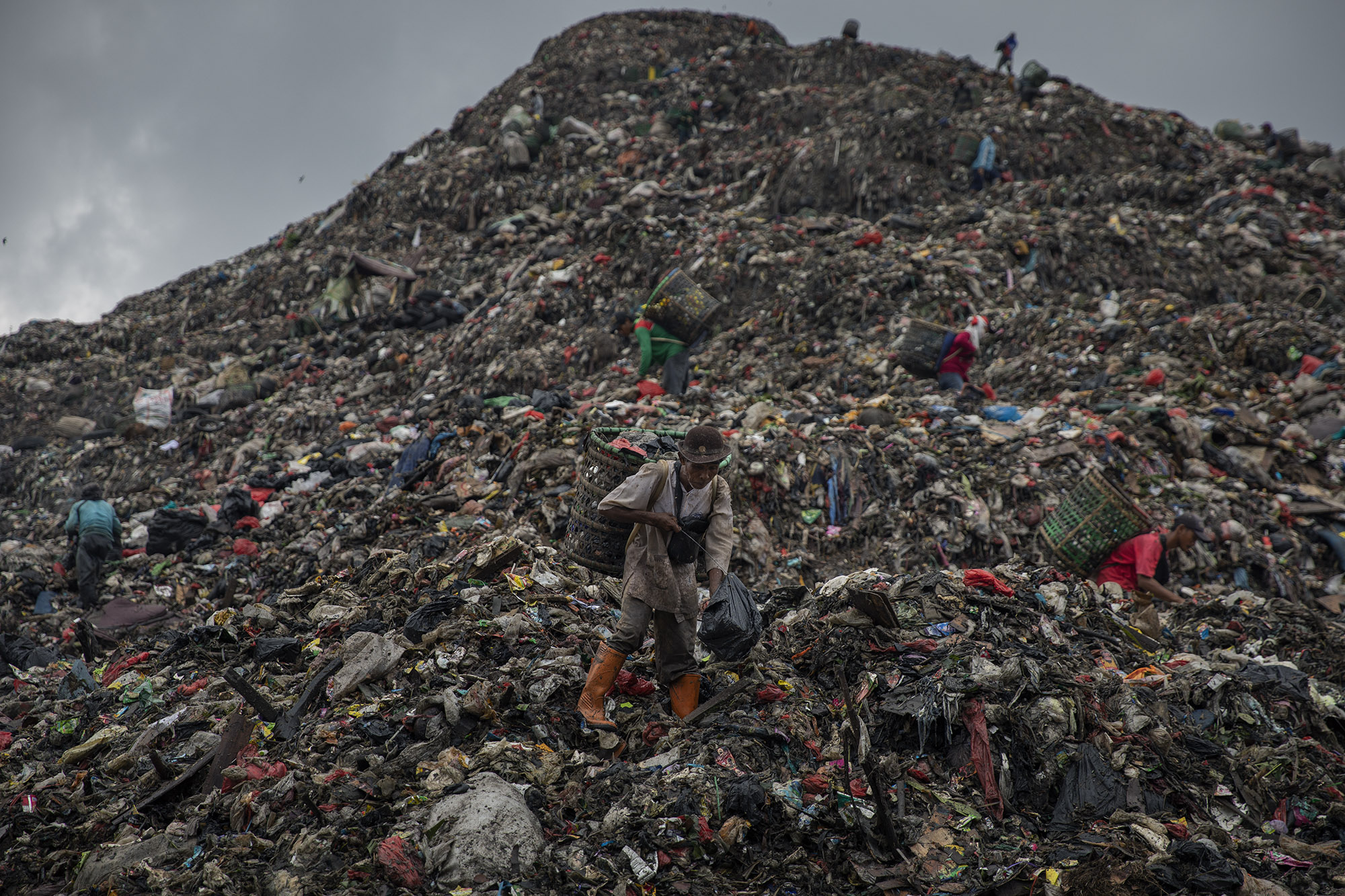
Hundreds of people separate trash at the Bantar Gebang landfill, the largest in the city. © Santi Palacios for Sonda Internacional
We watched the flow of the Ciliwung River for a couple of minutes, and what did we see in this liquid rubbish tip?
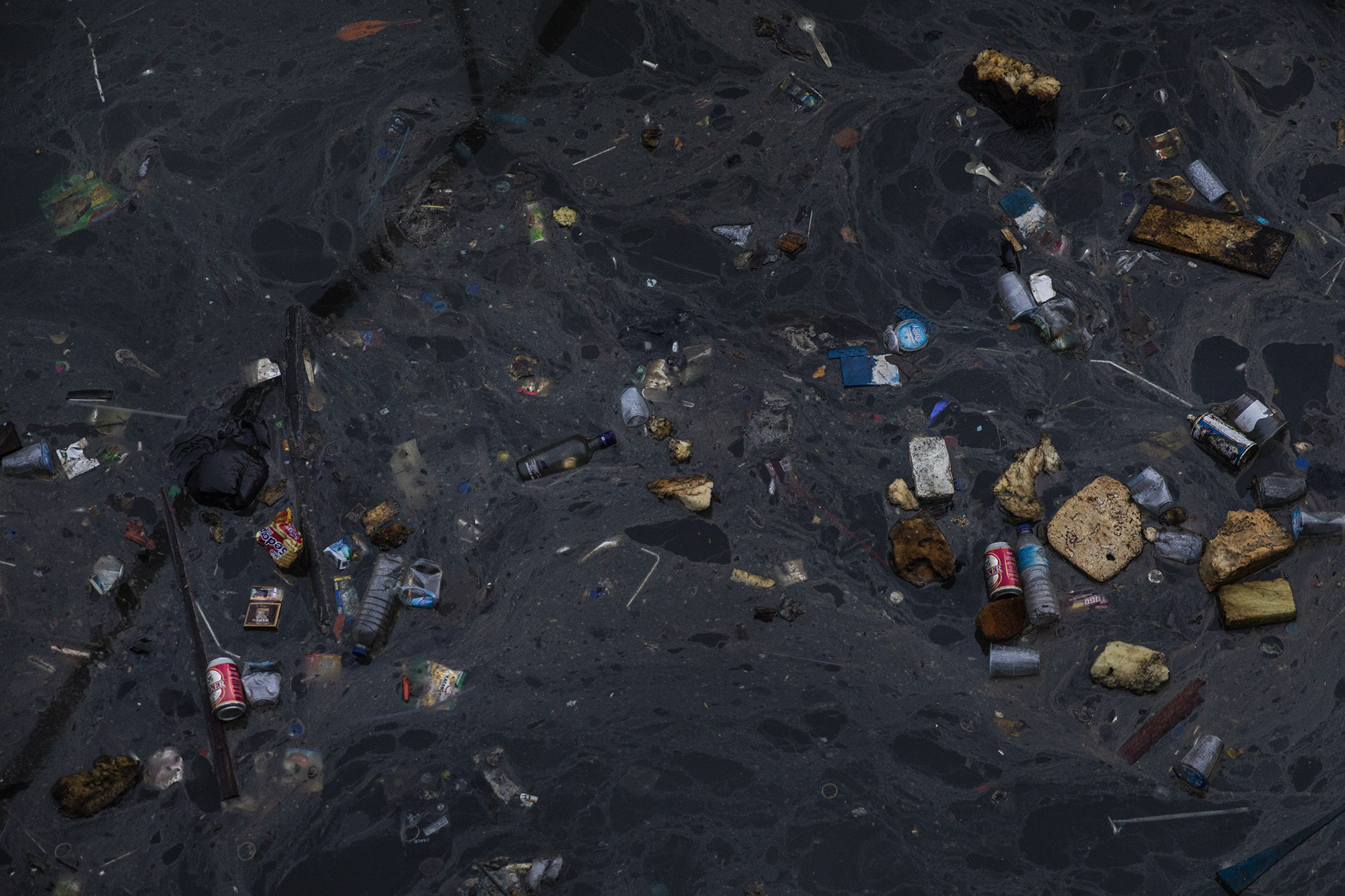
Garbage floating in polluted waters near where the Ciliwung River flows into the sea. © Santi Palacios for Sonda Internacional
Single-use shampoo sachets, plastic bottles, candy wrappers, noodle soup packets. A broom, a box of children’s playing cards, a black bag, a jug, a backpack. A plastic cup, and another, and another. A fan, a notebook, a mattress, a donut. A wooden board. A green rug, a black bag, a soccer ball and a cigarette pack. A diaper, a flip-flop, a hamburger wrapper. A log and a black bag full of garbage. A dead fish. A red wallet. A yellow plastic ladder. A bottle of cough syrup. A package wrapped in bubble wrap. A carrot. Another dead fish. A cutting board, a slipper, a milk carton, a corncob, the nozzle of a spray bottle. A blue comb. A black flip-flop, another plastic cup, a spoon. A purple ball, a red and white stuffed animal, another milk carton, bottle caps. A pink baby shoe, another black flip-flop, an empty sack, a fuse box, a round lid the size of a manhole cover.
A green plastic spinning top. A bottle filled with brown liquid. More bottles, more caps, more logs. A yellow bracelet. Another dead fish. A green hanger. Lots of Styrofoam peanuts. A slice of watermelon, a red propeller, a tire. A pink heart-shaped comb. More Styrofoam, more flip-flops. Tree branches, an eggplant, a black bottle with the word FYLUX on it. Another dead fish. A shampoo bottle, a plastic fork, a can of deodorant. A shoe insole, more Styrofoam, a cup o’ noodles. A soap dispenser, another bag of garbage, a ping pong ball, a bottle of shampoo. A blue spatula and a piece of green canvas and a blue spoon and a sandal and what looked to be a broomstick.
Next to us, a child throws a plastic bag with the leftovers of what he was eating into the river.
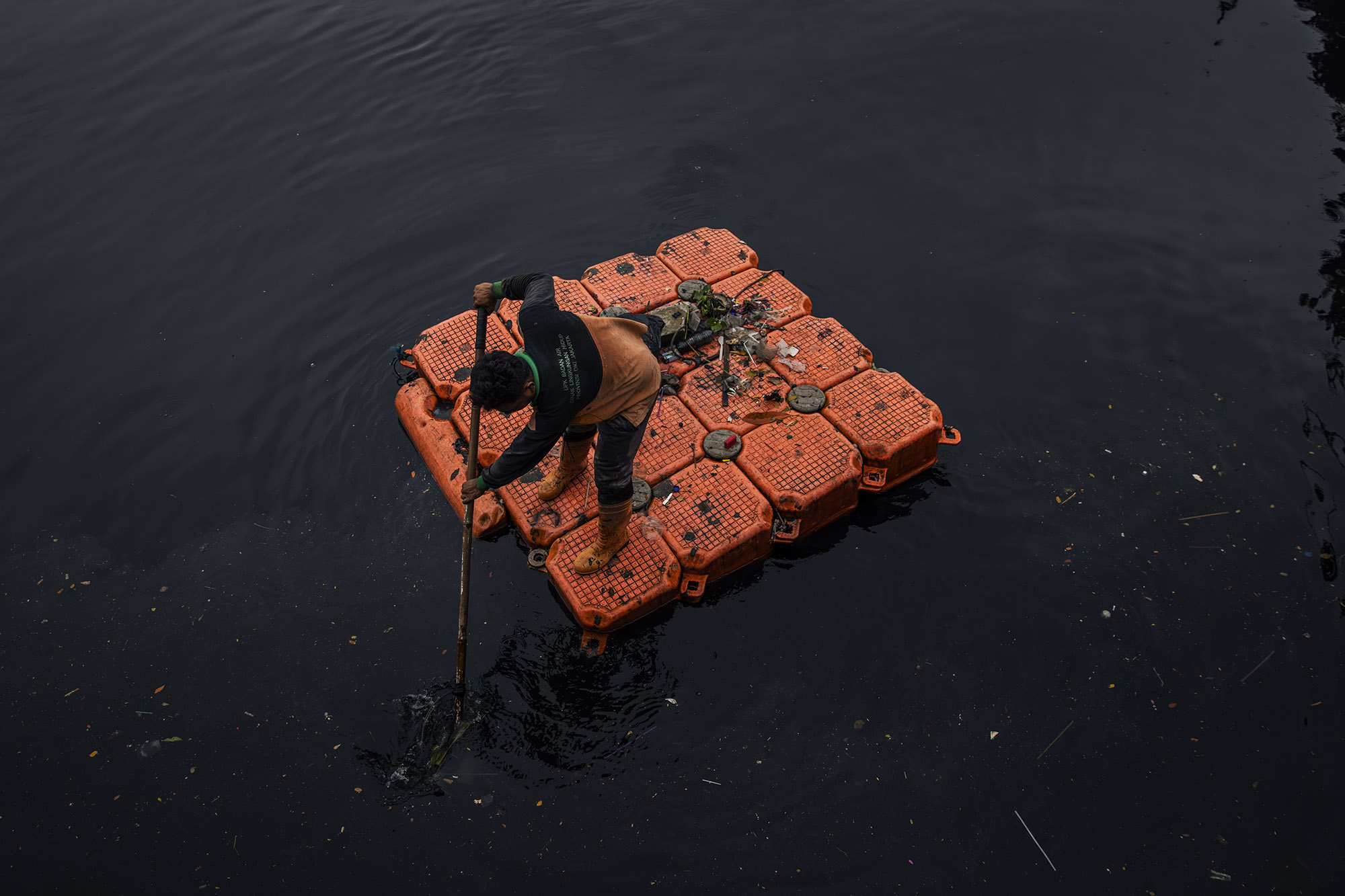
Municipal worker retrieving garbage from a river that cuts through the north of Jakarta. © Santi Palacios for Sonda Internacional
The waste collection and recycling scheme in Jakarta is woefully inadequate for managing all of the waste generated in the city. Most of the landfills have exceeded their original capacity and suffer from poor management, and much of the waste ends up in illegal dumpsites or is leaked into the environment. Nor are the clean-up schemes and equipment designated for watershed decontamination sufficient for removing all of the garbage floating in the city's waterways.
A study by the NGO Waste4Change showed that nearly 20,000 pieces of macroplastic (those measuring more than 5 millimeters) per hour are emptied into Jakarta Bay from the Ciliwung River alone.
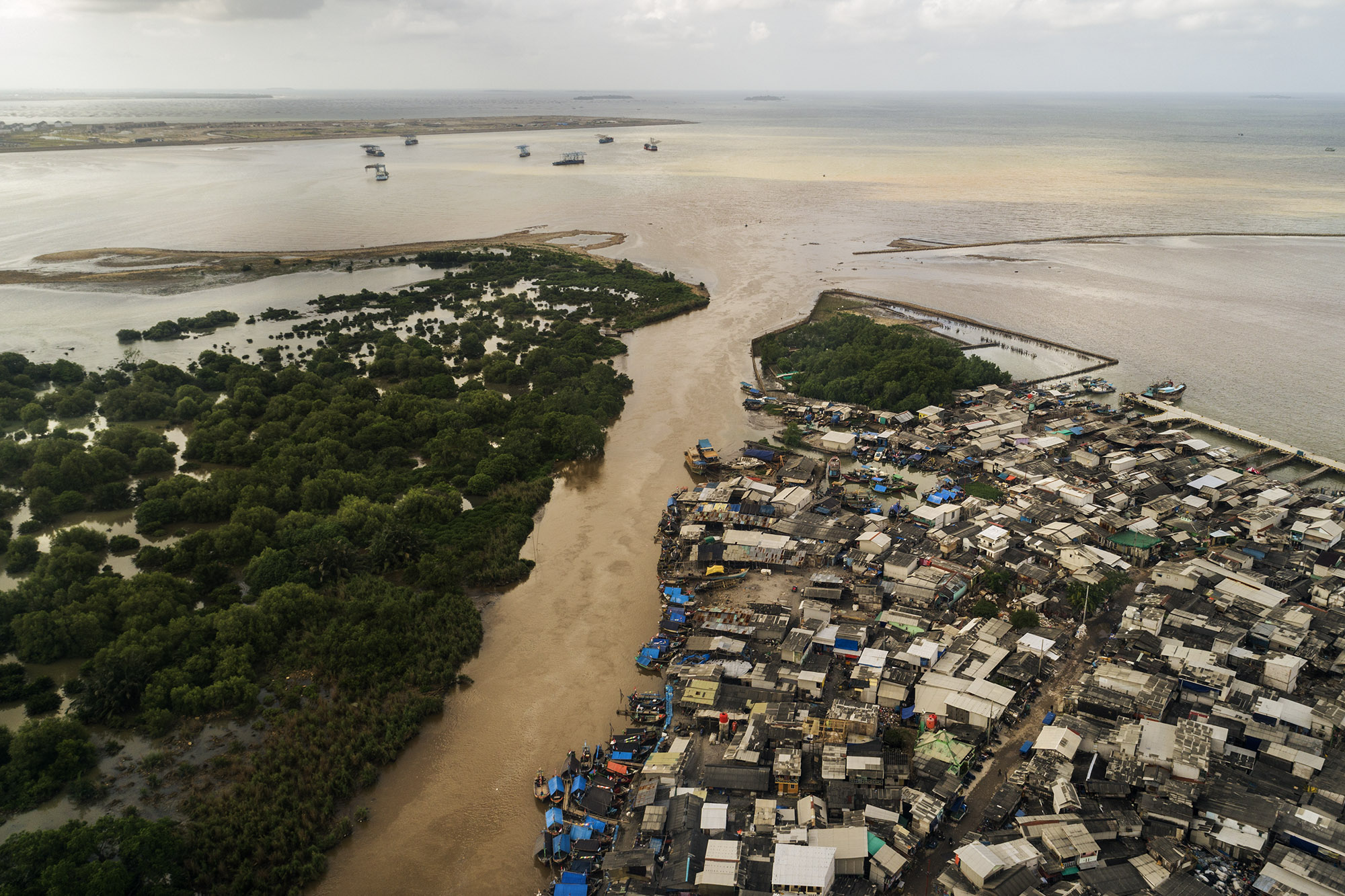
Aeriel view of the mouth of the Ciliwung River as it empties into Jakarta Bay. © Santi Palacios for Sonda Internacional
The shanty towns in the north of Jakarta, on the Java Sea, have traditionally been fishing villages. They are also home to some of the city's poorest residents. Thousands of families depend on the polluted waters of the bay for their livelihood.
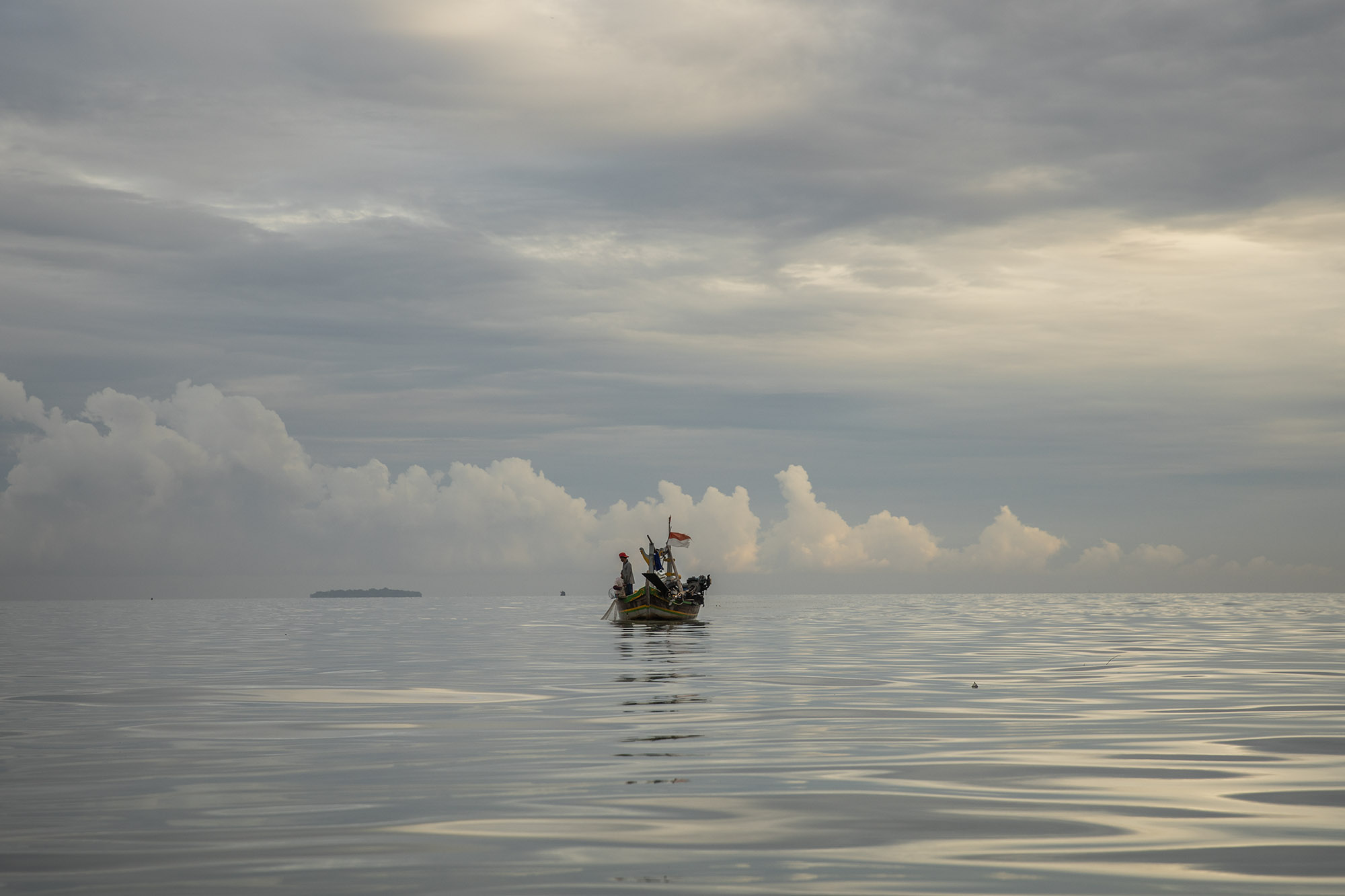
Fishermen fishing in Jakarta Bay. © Santi Palacios for Sonda Internacional
Every morning small fishing boats crowd the city's northern coastline. Flags have been placed in some areas where the amount of garbage and other waste that has accumulated on the seabed is so great that it can actually damage the boats.
In recent years, researchers have warned of the risk of pollution affecting the fish caught in Jakarta Bay, particularly after detecting unusually high levels of mercury and other heavy metals in mussels and other types of fish.
ACCESS TO WATER
Central Jakarta. © Santi Palacios for Sonda Internacional
Polluted rivers mean that access to drinking water is limited to groundwater, bottled water and running water that should come from the taps of homes and businesses. But the city’s water supply system is sorely outdated, in a poor state of repair and operates with a limited scope. Many of the pipelines and water mains date from Dutch colonial times, when a water distribution system was installed in what was then the European quarter. The poor state of repair of the system means that a significant amount of water leaks from cracks in the pipeline before reaching taps. In 2021, leaking pipes stripped the city of nearly 44% of its total water supply.
Estimates show that water from pipelines accounts for a mere 32% of the total amount of water used in the city. The remaining 68% is extracted from wells, bought bottled, or obtained through nyelang (derived from 'slang', the Dutch word for hose), the informal practice of buying water from neighbors who have wells or running water. The poorer the household, the more extensive the practice.
The city also uses millions of liters of bottled water per year.
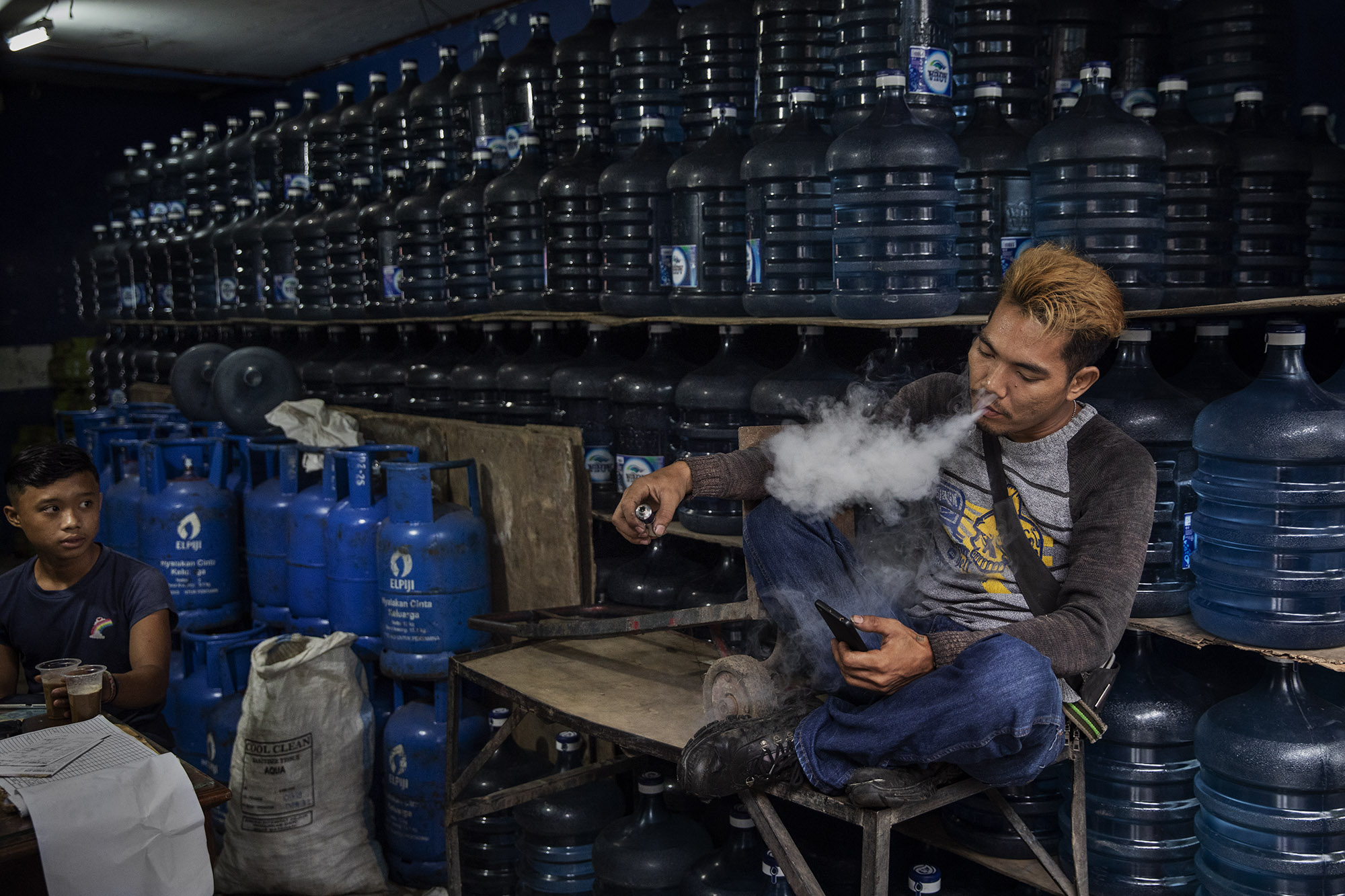
Tienda de agua mineral en el sur de Yakarta. © Santi Palacios para Sonda Internacional
Many of the wells are found in high-income areas. In the south of Jakarta, for example, water that is extracted from a depth of 100 feet is potable after minimal treatment. In the north of the city, in contrast, the proximity of the sea makes it difficult to find fresh water in the subsoil. This disparity is paradoxical: those with fewer resources are the ones who are forced to spend the most money on water.
The Constitution of Indonesia states that the water supply shall be controlled by the state, but in 1990 a wave of privatization swept the country and two companies —British-owned Thames Water and the French-based utility company Suez— took over water supply management in Jakarta. This was maintained until 2006, when the shares were sold to local companies (only Suez maintained a minority interest). In 2015, a court in Jakarta ruled that privatization of the water supply was unconstitutional and ordered control to be returned to the state.
Currently the publicly owned tap water company PAM Jaya supervises water distribution in Jakarta, although actual distribution has been awarded to two private companies in the wake of a privatization law that has not yet been superseded. “400 companies supply running water in Indonesia, but 50% of these do not supply safe drinking water,” says Sumengen Sutomo.
There are consequently hundreds of companies, both national and foreign, aiming to make a profit from the bottled water business.
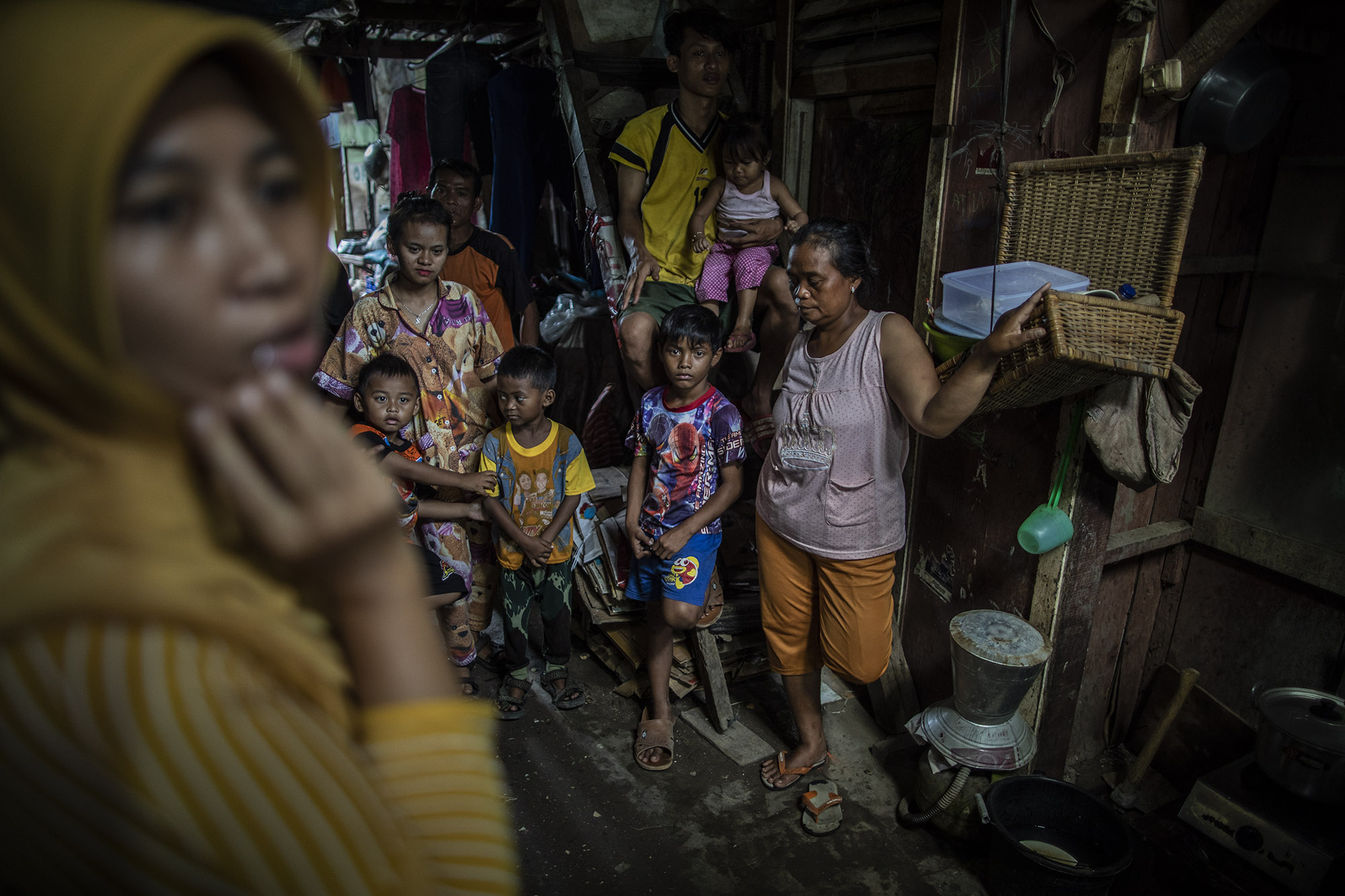
Community in the center of Jakarta where several families recycle plastic, cardboard and other materials. © Santi Palacios for Sonda Internacional
The Price of Water
Sopiah
Sopiah is 57 and lives with her family in Muara Baru, one of the areas of north Jakarta that inch by inch is sinking into the sea. They have no running water because the pipelines do not reach their house. Nor are there any wells nearby, because saltwater intrusion from their proximity to the sea has degraded the quality of freshwater aquifers. Three times a week the family buys water from a neighbor who does have running water, paying 50,000 rupiahs (around $3.50) each time they fill the tank. Sopiah calculates that the family, with five children and a three-year-old granddaughter, uses around 53 gallons of water per day. Buying water eats up nearly 30% of her monthly income.
Jabal and his wife, Nur Ellah, live in Bukit Duri in a very precarious shanty town on the Ciliwung River. Behind his house is a hand pump for pumping groundwater which the family uses for bathing and washing clothes. Water for drinking and cooking is purchased from a man who obtains it from the municipal water distribution system and resells it in blue jugs. Before use, they must boil it. They make their living from a small shop where they sell home cooked food. They use around three jugs of water a day, which they buy for 3,000 rupiahs each (about 20 cents). This adds up to 280,000 rupiahs a month, nearly the same as what the couple pays for their monthly rent.
Illian Deta Arta Sari lives in a large house in the center of the city. She buys a well-known international brand of mineral water for drinking. She uses one gallon a day, which costs her 23,000 rupiahs (around $1.50). For everything else, she uses tap water. She says that it is fairly clean and that supply is consistent. She has lived in this house since 2010 and has only been left without water three times, always as a result of flooding. On those occasions she went to his neighbor for water, as she has a well behind her house.
Dian Islamiati Fatwa lives in a residential area in the south of Jakarta, in a villa measuring nearly 11,000 square feet with a garden, a pool, and an auxiliary building with ten studio apartments that she leases. There is running water on the property, but they use groundwater from a private well with a powerful electric pump. They filter the water before consuming it, but they do not need to boil it. They also use well water for laundry, washing the car, and multiple showers daily. She pays nothing for her water supply, which is extracted directly from the subsoil, but she pays $200 a month for electricity.
JAKARTA IS SINKING
The gradual reduction of aquifers has significantly eroded the land on which the city is built. The problem is compounded by the weight of the buildings and rising sea levels. Together these factors have bestowed upon Jakarta the title of fastest sinking world capital. And it is plain to see: in suburbs like Muara Baru in the north, residents will point out areas that only a few years ago were dry land, now are underwater.
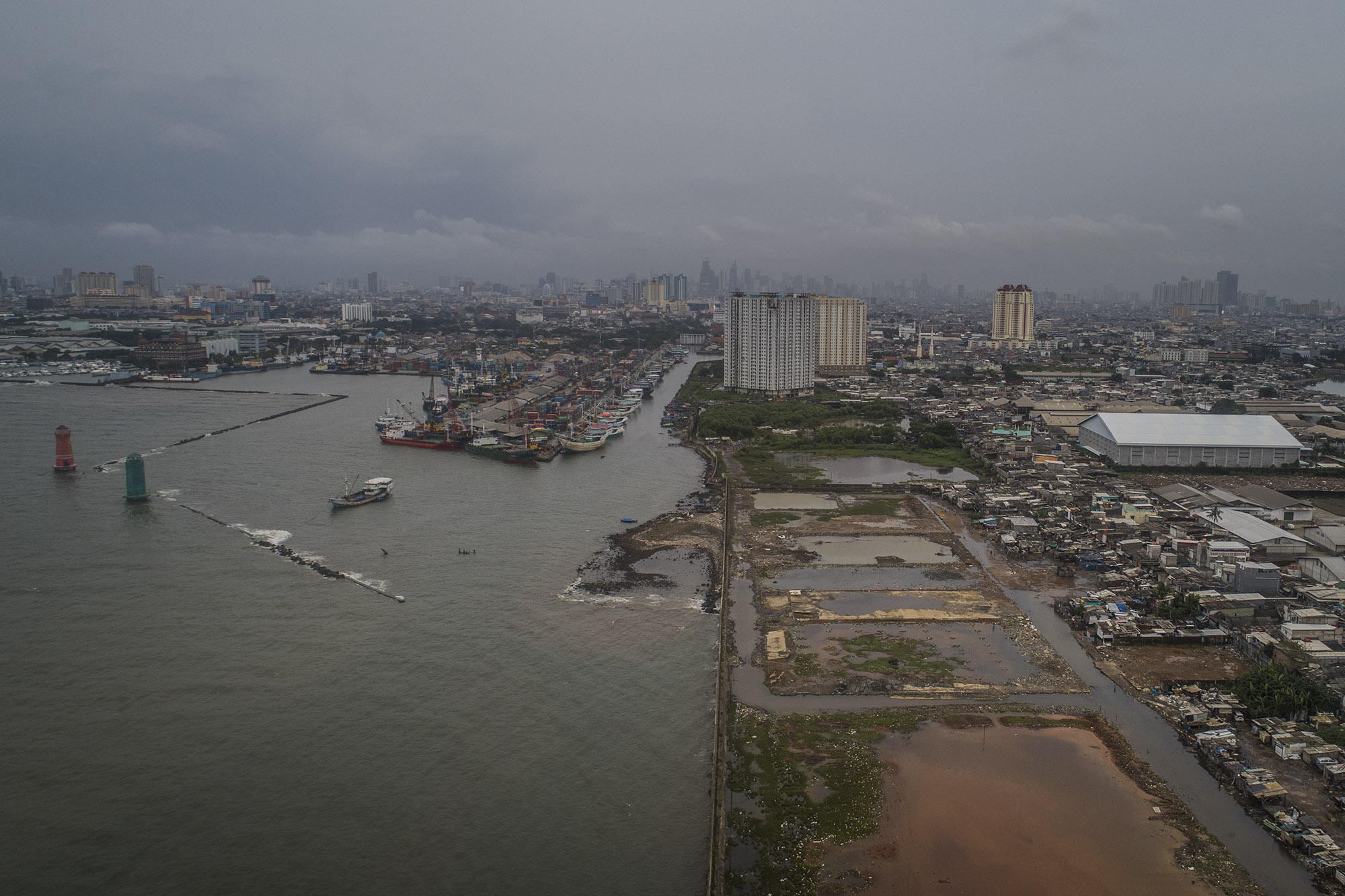
Aeriel view of a water retaining wall built in the north of Jakarta to halt the advance of the sea. © Santi Palacios for Sonda Internacional
The predictions are bleak. The aquifers continue to disappear, the sea level continues to rise, and some coastal areas are sinking at a rate of nearly eight inches per year. The sinking land also means that annual flooding worsens every year. Rivers burst their banks, and the canal system —a legacy from colonial times, choked with mud and garbage— is unable to drain the water that accumulates from the rainfall and ends up flooding the city.
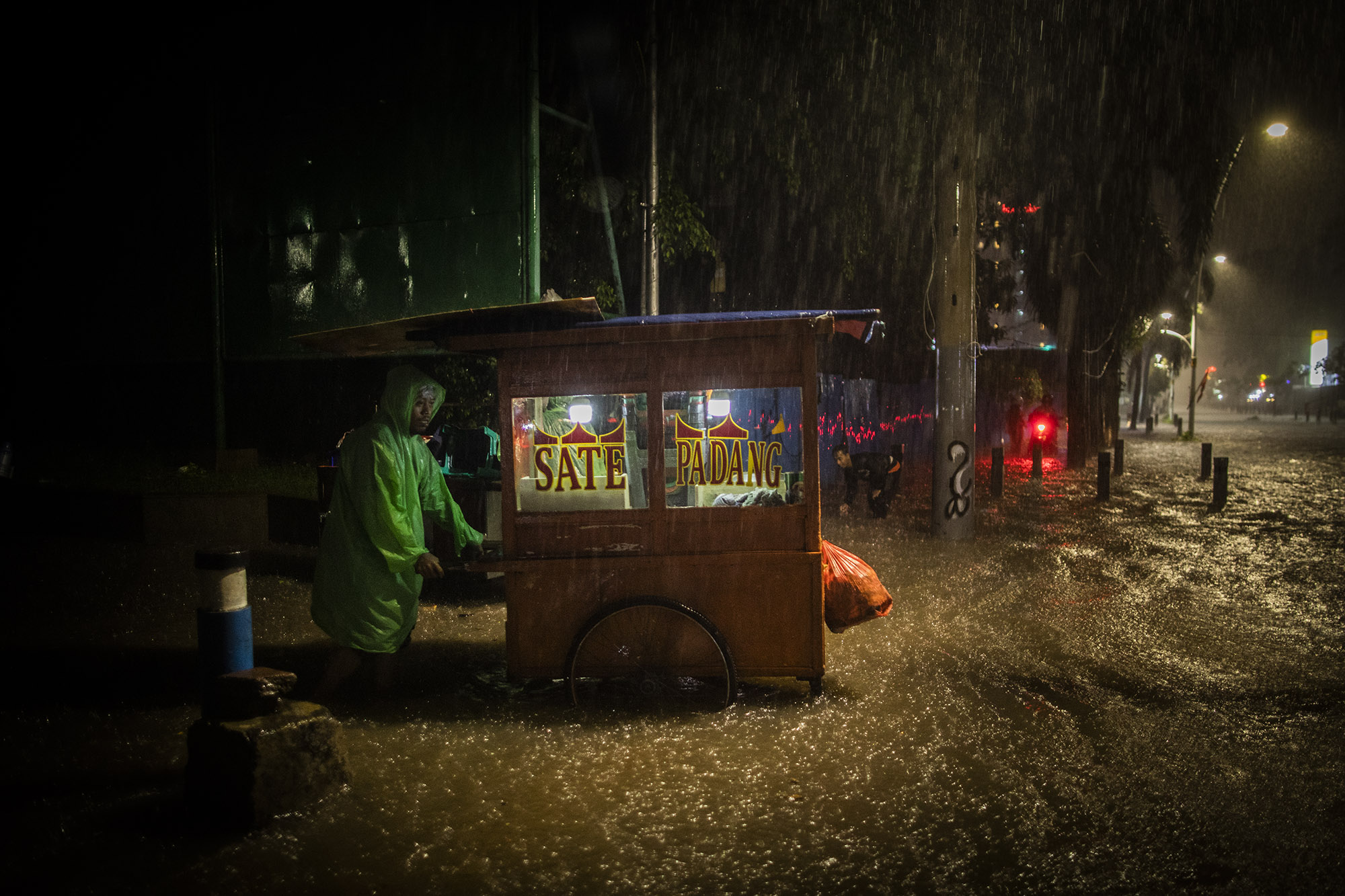
A street vendor selling satay is caught in a flash flood in the center of Jakarta. © Santi Palacios for Sonda Internacional
This situation, together with the chronic traffic problems in Jakarta, prompted the Parliament to pass a law last January to partially relocate the capital to the island of Borneo. The new city will be called Nusantara (“Archipelago” in Indonesian), and it is expected that the project will be executed in several phases between 2022 and 2045.
The decision has raised many doubts. On the one hand, there is the astronomical cost —around 33 billion dollars, although the government claims that only 20% will be taken from the public coffers. On the other, the project will have a significant impact on the region of East Kalimantan (Borneo), where it is expected to be executed. There are concerns that the environmental and human impact of a metropolis like Jakarta will be transferred, even if only in part, to what is now jungle.
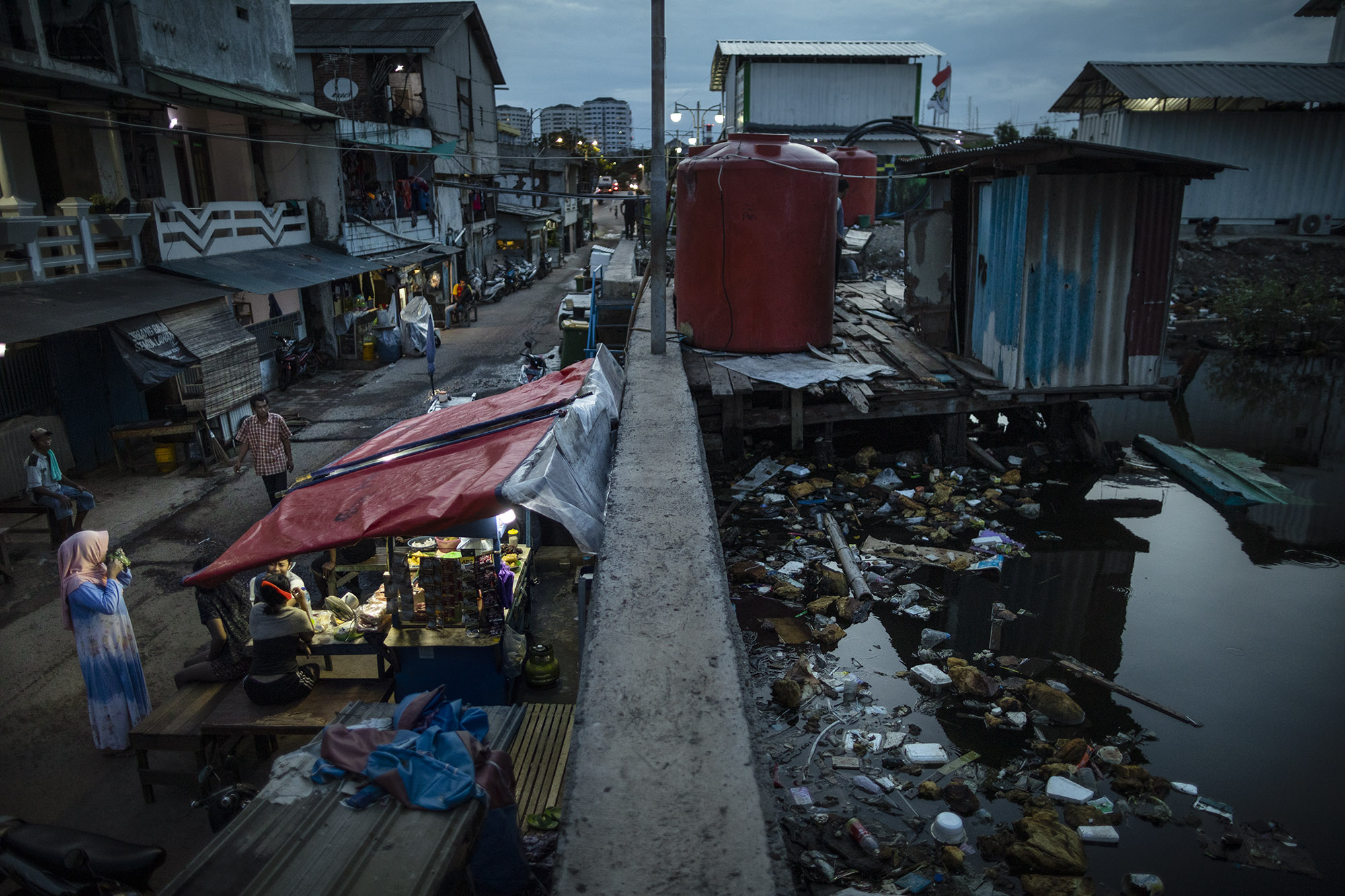
Water retaining wall in Muara Baru, in the north of Jakarta. © Santi Palacios for Sonda Internacional
While the Nusantara project is still in the planning stages, Jakarta continues to look for ways to protect its coastline. Starting in 2002, water retaining walls have been built in several coastal areas of the city. Since 2014, an ambitious plan to build the Great Sea Wall has been on the table. This was conceived as an enormous three-layer coastal barrier that would serve to halt the advance of the sea, act as a promenade, and at the same time, as a type of dam for the rivers that cut through the city. The project has been reevaluated several times, and while some progress has been made in the planning stages, it has been postponed due to the prohibitive costs of implementation.
The ramifications of a sinking Jakarta are a colossal challenge. In this context, the risk lies in that large infrastructure projects —the wall, or moving the capital— can divert attention from a more pressing need: “A lack of safe drinking water,” insists Sumengen Sutomo. Availability is “not a problem of technology, but rather of water management.”
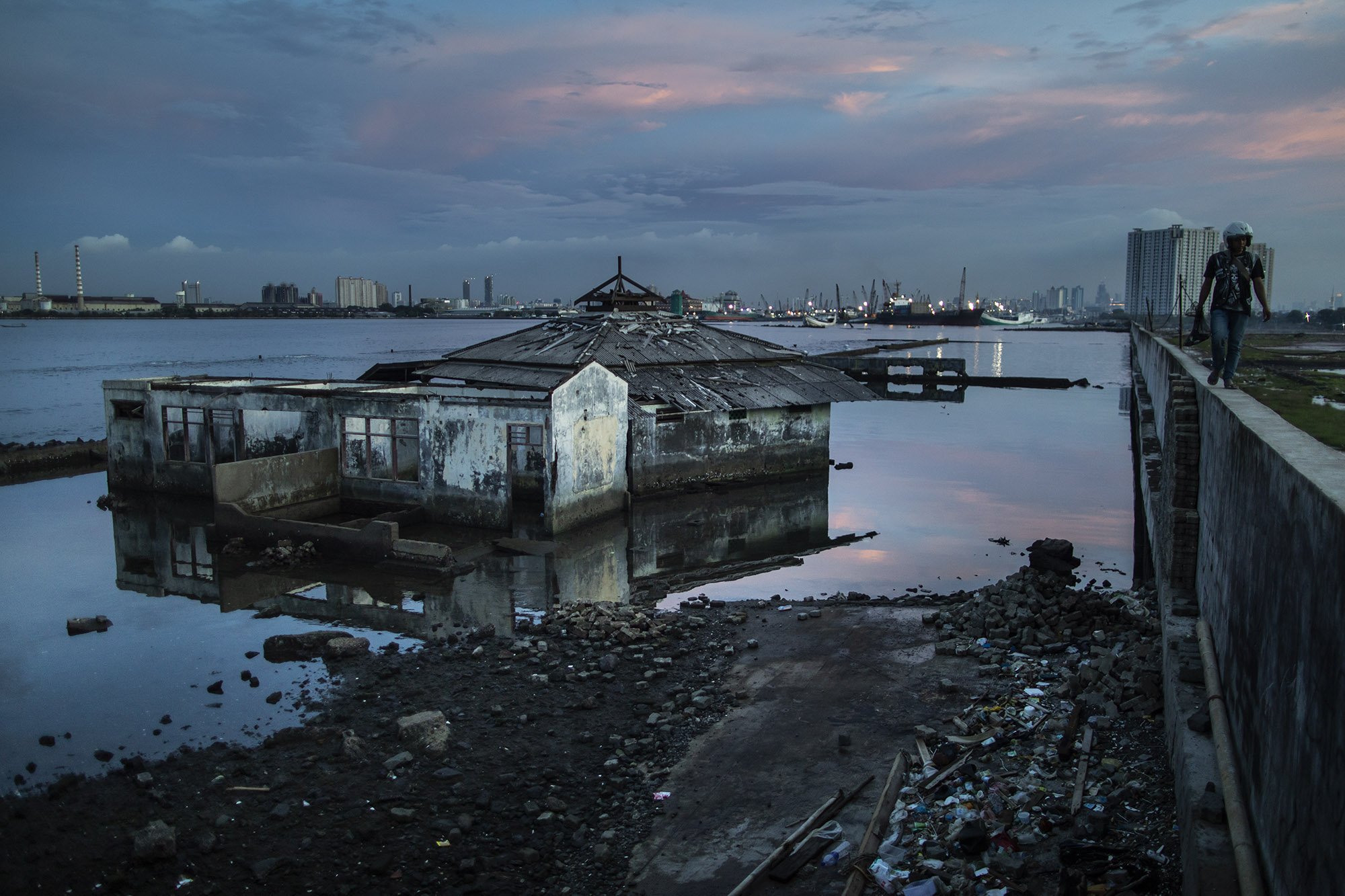
The Wal Adhuna mosque in the north of Jakarta lies partially underwater, as it succumbs to rising sea levels. © Santi Palacios for Sonda Internacional


